Throughout humanities classes, issues of race, gender, sexuality, religion, and other potentially “sensitive” issues frequently arise. Each of these topics—from discussions of slavery in Fifth Form United States History classes to those of religious extremism and nationalism in Fourth Form World Literature—turns up the metaphorical heat in classrooms, leading to intense and passionate dialogue. Humanities teachers find that these topics are crucial both to the basic understanding of their course content and to the overall goals of their classes and the school as a whole.
According to English teacher Ms. Emily Harnett, covering social and political issues within the humanities curriculum is a facet of Haverford’s mission.
“In addition to teaching critical skills— reading, writing grammar, vocabulary—we want to teach you guys to be better global citizens and better American citizens, and in order to do that you need to know what Americans are talking about,” Ms. Harnett said.
Exposure to the issues that are prevalent in society today—especially in the midst of the “culture war”—is a goal of some Haverford educators.

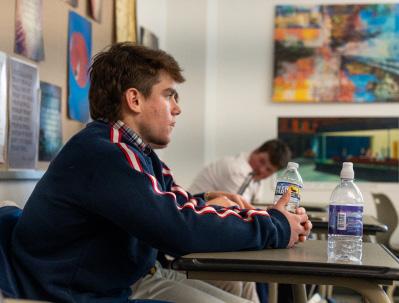
con’t on p. 8
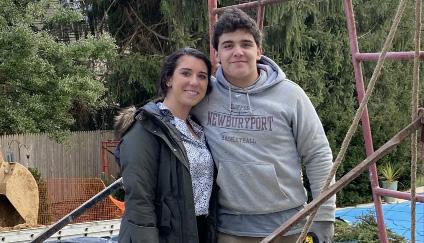
Teachers manage sensitive discussions in humanities classrooms
Spring rowers score big on the home stretch

For the first time in over twenty years, the crew team won the spring Horvat Manny Flick Series regular season Boys Sculling points trophy. The trophy is awarded to the team that best performs in either sculling or sweeping events throughout the regular Manny Flick season.
This victory was not much of a surprise since several Haverford sculling boats performed well at various points throughout the series. Most notably the freshman quad, novice double, JV double, lightweight double, lightweight quad, and varsity quad all enjoyed successes this regular season, adding to the points collection. All of these boats have consistently placed top three in their respective races throughout the Horvat series.
Now the team’s focus shifts from the regular season Horvat series to the “playoffs” of spring crew: City Championships, the Stotesbury Regatta, and SRAA Nationals. The team hopes to continue its success and win medals.
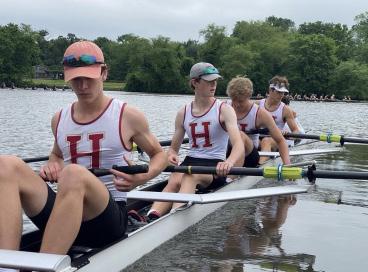
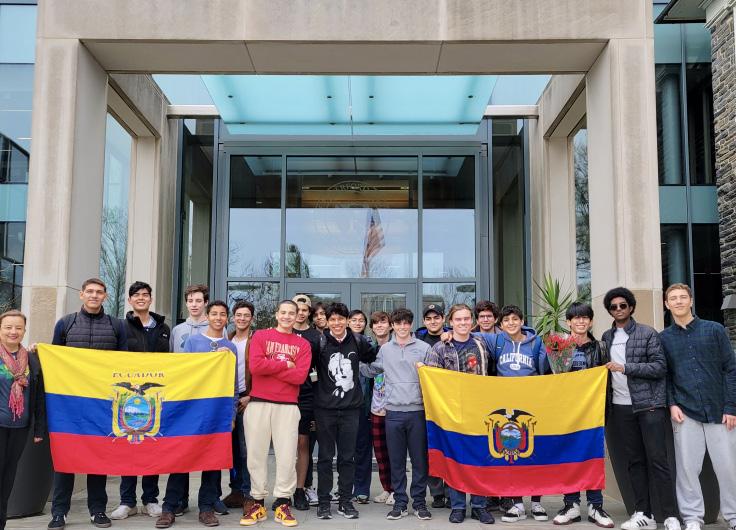
Luckily, the spring weather has been pleasant, and the team has been able to get ample training time on the Schuylkill River. This, combined with on-land erg and general fitness workouts, has helped boost fitness levels while improving technique.
con’t on p. 19
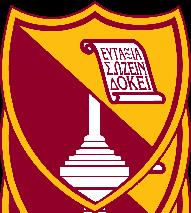
PIERCE
LAVERAN ’24
The
· May 2023 · Volume 90, No. 8 · thsindex.org the index The student voice since 1888
Andrew Lyon ’23 during an English III discussion in Dr. Del Rosario’s room
Haverford School · Haverford, PA 19041
Alir Gladden, p. 17 OWEN YU ’23 Ecuador, pg. 6 MR. ANDREW POOLMAN Lucio Accione, pg. 5 COURTESY OF LUCIO ACCIONE ‘23 Lacrosse, p. 19 MS. LAURA BARR
Ryan Brewington ’24
Ian Rosenzweig ’25
COURTESY OF QUINTIN BOWERS ’24
Quintin Bowers ’24, Jackson Harrington ’24, Alex Herrmann ’23, and Jack Squillaro ’23 leave the dock
the index
2022–2023 Staff
Jingyuan Chen ’23
Editor-in-Chief
Joey Kauffman ’23
Editor-in-Chief
Connor Pinsk ’23
Editor-in-Chief
Ethan Chan ’23
Senior Managing Editor
Owen Yu ’23
Senior Managing Editor
Ethan Lee ’24
Managing Editor
Adiyan Nayak ’24
Managing Editor
Christopher Schwarting ’24
Managing Editor
Casey Williams ’24
News Editor
Arsh Aggarwal ’24
Features Editor
Ian Rosenzweig ’24
Academics Editor
Tripp Ronon ’24
Neighborhood Editor
Connor Simpkins ’25
Campus Opinions Editor
Charlie Kiedel ’24
Off-Campus Opinions Editor
Russel Yoh ’24
Arts Editor
Tate Conklin ’24
Sports Editor
Pierce Laveran ’24
Photography Editor
Ms. Emily Harnett
Faculty Advisor
Mr. Thomas Stambaugh
Faculty Advisor
The Index is a student-run publication of the Haverford School that does more than bring news: it provides the diverse perspectives of the Haverford student body. It is an outlet for student writers to take stands on issues they deem important. It chronicles the daily struggles and accomplishments of the Haverford community. The Index also provides a forum for discussion of pertinent issues, such as student culture, academic policy, and Haverford’s place in world affairs. The Index presents new ideas and aspires to influence constructive change.
All opinions and viewpoints expressed herein do not necessarily reflect those of The Index or the school. The Index is designed and produced digitally. Photographs may be retouched. Submissions and letters to the editors regarding any and all articles are welcomed at index@haverford.org
The Index, a member of the Columbia Scholastic Press Association, is composed using the applications of Google Suite and Adobe Creative Cloud. Its surveys are conducted via Google Forms and are advertised on email to current Haverford students. Graphic designs are created by Index staff via Canva. Southern Dutchess News prints 200-400 copies of each issue, and its editorial staff distributes them in the Upper School on the day of release. The Index serves the needs of a total school population of 1152 community members, consisting of 952 students and 200 faculty and staff members.
Contact The Index:
450 Lancaster Ave, Haverford, PA 19041 index@haverford.org
Twitter: @Haverford_Index
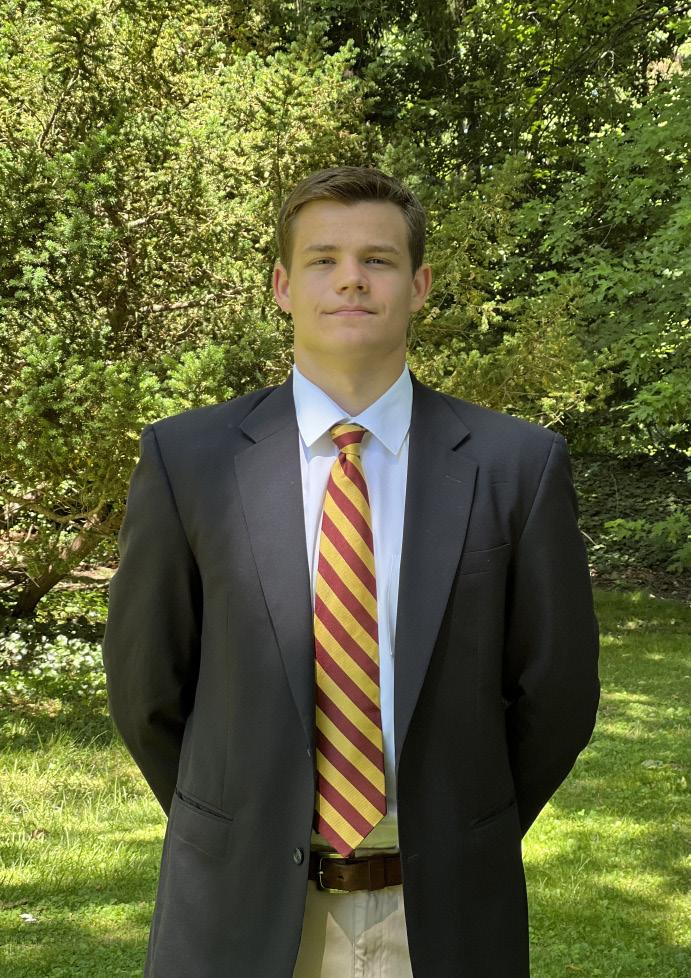
Instagram: @Haverford_Index
Volume 94, No. 8 - May 10, 2023
editorial
Passing the torch
Every May at Haverford is a season of transition and transformation. The annual Rosettes Ceremony approaches, marking the final assembly session for the Class of 2023. From Honor Council elections to sports’ Senior Days, Sixth Formers who played vital leadership roles in scholastic and athletic programs pass their torches to the next generation of aspiring leaders.
The Class of 2023 was the first class to emerge fully out of the effects of the pandemic and lead the community to return to normalcy and re-strengthen its bonds.
As retiring leaders of the upper school, the Class of 2023 has left its mark on many facets of the community—a legacy that rising leaders will come to appreciate and build off of.
For the Sixth Formers themselves, only finals and a few weeks of graduation projects stand between their last days at Haverford and the summer before college.

Looking back to this day a few months from now, there will be much to appreciate, many to thank, and much to miss about the Haverford experience.
For rising Sixth Formers, now would be
the time to challenge yourselves, put yourselves out there, and envision your roles as future leaders of the community.
While not every attempt at an application will be successful, fortune favors the bold—those who dare to try will have a better chance at success than those who don’t. Imagine yourselves in leadership roles, and think about the things you can achieve with this power. Carry on the torch. Carry on the Fords’ spirit.
Letter from the student body president
It’s one thing to have faith to get started, but it’s another thing to have the fortitude to finish strong.
We are at the end of the road; the weather’s getting warm, Memorial Day weekend is near, and so is graduation. But we must not lose track of our values and what is important. Just because the weather is getting better does not mean we can put our main goal, our collective integrity, in front of our short-term needs. By procrastinating, you will find yourself with long nights of homework and studying; and although you might be successful for a few weeks, the stress and lack of sleep will eventually get to you.
We have overcome many challenges already this year, but we cannot afford to become complacent now. The final stretch can often be the most demanding, but it is also the most crucial.
It is a time when we must push ourselves to achieve our goals, and perhaps even exceed our own expectations. With the right mindset and the continued support of our community, we can make the most of these final months and finish the year on a strong note. There’s not much else to say except to take a deep breath and embrace your future roles for next year.
Fifth Formers, you guys are now the face of the school. Own your role as the most tenured in the chain of command. You’ve seen a lot of things you liked this year and things you didn’t like.
Use what you learned for next year, and demonstrate your leadership abilities when the current Sixth Formers leave. Third and Fourth Formers, learn from the Fifth Form and create healthy relationships between one another.
Respect and love each other as the brothers that you are.
April 2023 Page 2 the index · editorial
COURTESY OF LUCA SEKULIC ’23
Luka Sekulić ’23
2022-23 Editorial Board (from left to right), Editors-in-Chief Joey Kauffman ’23, Connor Pinsk ’23, Jingyuan Chen ’23)
MR. THOMAS STAMBAUGH
School feels Mr. Kolade’s temporary absence
In a bustling upper school, the figure of a dean embodies order, discipline, and most importantly, harmony. Students and staff alike rely on their dean to create a bridge between all parts of the community, and without them, a community threatens to fall apart.
With Mr. Luqman Kolade’s absence, the administration had to take several steps to make the transition as smooth as possible.
“Mr. Kolade is an invaluable asset to the upper school,” Head of Upper School Mr. Mark Fifer said. “Just his presence alone adds a lot, so there were some things we could account for and other intangible things that were hard to account for.”
known to be on top of, was another thing the administration had to make accommodations for. Third Form dean Mr. Stephen Cloran took the lead on sending notes to students with unexcused absences. Despite his efforts, students feel a noticeable difference in enforcement.
“Anytime you take a Mr. Kolade out of the mix, because he is such a fixture here
in the student world, there is bound to be some level of impact. I don’t know if I’ve felt a significant shift in seismic ways. Just a little more laziness and perhaps a little fraying around the edges with the dress code,” Mr. Fifer said.
Nonetheless, the administration has done a superb job of filling the all-encompassing role of a dean like Mr. Kolade, and is definitely looking forward to his return on May 15th.
“I am really looking forward to having Mr. Kolade come back. He is such an important part of what we do around here, and I can predict the students are looking forward to seeing him as well,” Mr. Fifer said.
After a series of meetings, Mr. Kolade’s responsibilities were evenly distributed amongst the four form deans. Things like following up with attendance, afternoon detentions, and community programming all had to be accounted for, however, the form deans were up for the task.
“For me, the biggest thing has been standing up in front of everybody in the assemblies,” Sixth Form dean Ms. Brooke Kenna said. “Mr. Kolade has a natural way about it, so it’s big shoes to fill, but it’s been a lot of fun. I think I’ll be ready to hand it back over to him when he gets back.”
Attendance, something Mr. Kolade was
“Personally, I’ve noticed that after Mr. Kolade’s absence there hasn’t been as much strenuous enforcement of communal standards within the school, like dress code, skipping assembly, skipping class,” Sixth Former Dylan Kao said. “One example of this is the visits Mr. Kolade made to classes to talk to kids who have skipped class or assembly. Ever since Mr. Kolade has gone on leave, this stopped completely.”
Despite having less enforcement in certain areas, the overall atmosphere of the school has not changed as drastically as the school had prepared for. The student body, for the most part, has remained in dress code, kept up assembly attendance, and generally maintained a respectable communal environment.
Parking grows even more limited
At Haverford, the number of student drivers continues to increase, and only a portion of the Sixth Form can park on campus. The area around the school is mainly residential with some commercial areas around further down Lancaster Avenue.

While Haverford does provide parking for some Sixth Formers, the school still
doesn’t solve the problem for Fourth and Fifth Form drivers.
As a result, students park in and around the various commercial parking areas such as the Main Line Art Center, which charges students $100 a month to park in their lot. Students also park on Buck Lane, Booth Lane, and at the Haverford train station. Recently, a new space has opened up: all along Old Lancaster Road, right off Booth Lane, offers four-hour parking.
“Usually the parking situation is fine. A lot of kids don’t pull up their cars and leave a lot of space, but there are usually plenty of spots as long as you get to school at like 8:20,” Fifth Former Ben McComb, who parks on Panmure Road, next to Eagle Field, said.
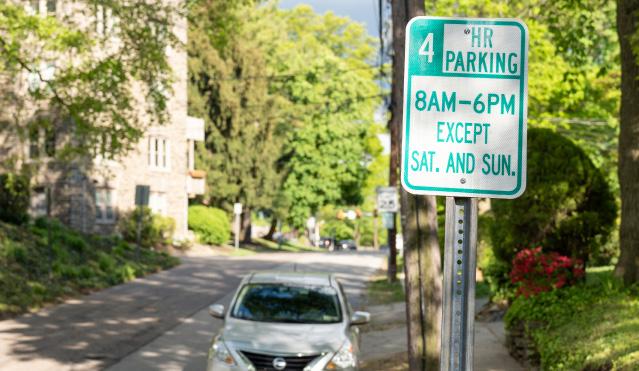
Considering how the school could add more parking spaces for Fourth and Fifth Formers, McComb said, “I don’t think there’s that much of a need for more student parking spaces, but it would be nice.”
This new addition has certainly opened up new opportunities for these students to get as close to school as possible in the mornings. Fourth Former Reilly Hope currently parks at Old Lancaster in the mornings, taking advantage of the free two-hour parking, then later moves his car to Booth Lane during lunch. However, while having to move his car, he’s run into some difficulties.
“It’s kind of annoying having to move,
and I’ve gotten [about] three tickets since February 26th,” he said.
Other members of the community express more frustration with the parking situation on campus.
“The parking on campus is kind of ridiculous,” Sixth Former Johnny Herd said. “I know we don’t currently have the room for more spots on campus, but the administration should try and do more to dedicate spaces for student parking.”
Another issue constantly arises for Sixth Formers: their assigned spots being taken.
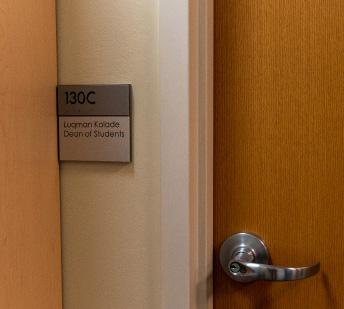
“My spot and my friends’ spots have
been taken all the time,” Herd said. “Not usually by other students but by parents and visitors. I think if the red lot were more clearly labeled as being student parking, it would help.”
The current question to students now is whether the school does anything about parking or not. This question likely will not be answered with the current amount of space the school has. The question now should be, will there be parking provided at the new campus at Roberts Road for members of the Fifth, Fourth, and maybe even Third Forms?
Arsh aggarwal ’23
Mr. Luqman Kolade’s office, closed for now
Quinn sullivan ’25
A four-hour parking sign on one side of Old Lancaster Road PIERCE LAVERAN ‘24 PIERCE LAVERAN ‘24 news the index · news May 2023 Page 3
“For me, the biggest thing has been standing up in front of everybody in the assemblies.”
MS. BROOKE KENNA
“Personally, I’ve noticed that after Mr. Kolade’s absence there hasn’t been as much strenuous enforcement of communal standards within the school, like dress code, skipping assembly, skipping class.”
DYLAN KAO ’23
“I am really looking forward to having Mr. Kolade come back. He is such an important part of what we do around here.”
MR. MARK FIFER
Students’ financial dreams: do we sacrifice passion for success?
What puts Haverford on the map? What differentiates us from all the other nearby schools? What makes our school so unique?
One of the biggest factors that attracts so many kids to attend Haverford may have little to do with the school itself, but rather with what students do when they graduate. For a parent, knowing that attending Haverford will lead to a strong college search process and will “prepare boys for life” is a reassuring consideration when choosing a high school.
The school is well known for sending its students to some of the best institutions in the nation. And it doesn’t just stop there, as many of our alumni keep progressing and succeeding after college. Haverford students have clear ideas, strong paths, and a desire for success; however, it goes further than just having “better teachers” or “the smarter kids.”
The school fosters a culture among the students of wanting to be the best and succeeding.
“I think that the drive for success is great here. I think that it’s competitive being an all-boys school,” Sixth Form Dean and Spanish teacher Ms. Brooke Kenna said.
This quality can be observed in students’ academics and athletics, but this is especially noticeable in their choices for what major they want to pursue in college, and what path they want to take after graduation.
“Finance attracts the most interest,” said English teacher Ms. Emily Harnett. “I also think a lot of things are grouped under that, like banking jobs, consultant jobs, and marketing jobs. Just things in the business world, especially in the sort of financial services, is what a lot of our students end up going into.”
There is a trend within the graduates of heading into finance as a career path.
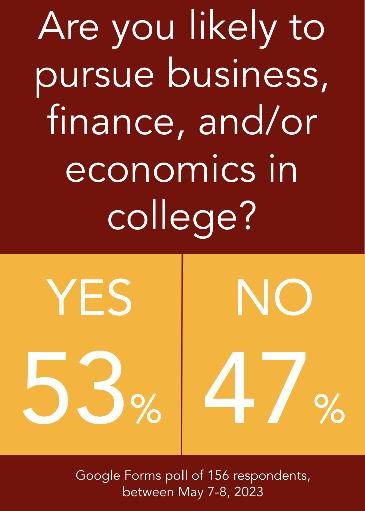

Ms. Kenna confirmed this, saying, “We have seen quite a bit of finance and business, but I think even in the past few years that has changed, so it will be interesting to see where this goes moving forward.”
Despite the large-scale matriculation into the business world of the school’s alumni causes some to wonder: do these boys choose this path based on their passion for the subject or their desire for wealth and a successful career?
“A lot of the classes that they enjoy are humanities classes: they like discussing big ideas,” Ms. Harnett said. “Many people like the atmosphere of having some intellectual conversations, and yet they tend to choose career paths which don’t reward those sorts of activities. Something that I worry about is my students who I used to teach who are now graduated, who are picking specifically
a subject which they didn’t enjoy much in high school because they think that subject will make them a lot of money one day,” Ms. Harnett said. “Of course I also understand why they are doing that.”
“I also understand that college is enormously expensive, and for that reason it makes perfect sense as an investment,” Ms. Harnett said. “What would make me sad is if they picked these jobs, which was just a grind, which made them unhappy, which didn’t align with their values, just because they felt like they had to in order to achieve a certain lifestyle one day.” While many may simply choose business as a way to fund their ideal lifestyles, some may also be adept in the field.
“It depends on the student. I think there are students who are genuinely interested in business,” Ms. Kenna said. “However I think [there is] the perception that [finance/business] is a successful career, so that probably plays into it a little bit.”
Sixth Formers close out final spring concert
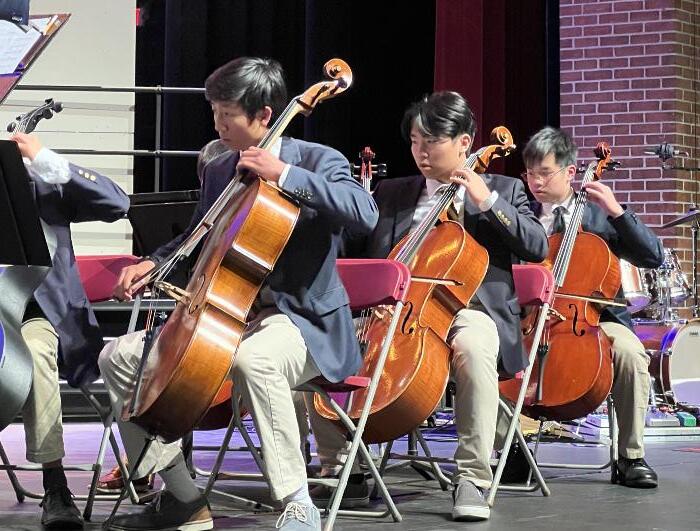
Bittersweet emotions filled the air as the final notes from the string orchestra rang out in Centennial Hall, signaling the end of the annual Spring Concert. The concert was a last hurrah for many involved, including the Sixth Formers graduating from the school in a few short weeks.
“I feel good that everything is done, and
I feel like we had a great year,” music teacher and Notables director Mr. Matthew Mastronardi said. Like the Sixth Formers, he too is leaving at the end of the school year, but his outlook is more optimistic than most would expect. “It’s a bittersweet feeling […] I’ve grown so fond of everyone that I’ve worked with throughout this year and I am going to miss them, but I’m grateful for the opportu-
nity I had to work with everyone.”
A few Sixth Formers are choosing to leave their mark in a unique way. For Sixth Former Alphonso Evans, this meant arranging the hymn “Lift Every Voice and Sing” for the Notables with help from Mr. Mastronardi. It meant a lot for him to be able to not only leave his legacy, but help to give other Black students on the Notables something to
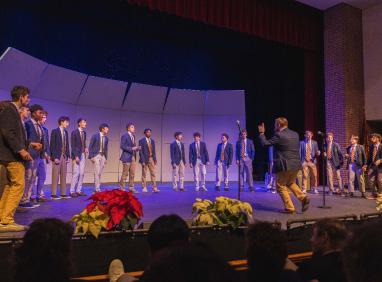
Is seeking wealth an agenda pushed by the school? Does this drive come solely from the student, or does the school push them as well to aim for wealth in the future?
“If you were to ask any teacher here what their top five goals are for their students, I don’t think making money would be in the top five for any of them,” Ms. Harnett said. “What I think is true is that teachers want you to live happy and fulfilling lives.”
Haverford is a liberal arts school. However, since many students end up going into the same area—finance—this raises questions whether our liberal arts education is effective and working.
“A Haverford boy is usually a wellrounded boy, and so no matter what path you pursue post Haverford, you’ve had all these experiences in the liberal arts and the humanities,” Ms. Kenna said. “I think we’re doing a very good job of sending these boys out as complete human beings, not just finance majors.”
feel connected to.
As the Sixth Formers say their goodbyes, many spots are left open for Fifth Formers to fill, especially in leadership opportunities. Fifth Former Chase Nelson is looking to move on from Glee Club to the Notables. “Well, I haven’t joined yet,” Nelson said, “but if I do, I’ll be really excited and happy to contribute to the program.”
Luca Aloi ’25
Mr. Brian Long looks at financial markets in his classroom
Alir Gladden ’23
the Winter
at Centennial Hall, December 6, 2022 COMMUNICATIONS PIERCE LAVERAN ’24 features the index · features May 2023 Page 4
The Notables perform in
Concert
May 4, 2023 THOMAS PENDERGAST ’23
Cellists perform in the orchestra during the spring concert,
For Lucio Acchione ’23, masonry is a family affair
As the school year comes to a close, summer break is on the horizon, and many students begin the search for a summer job.

For Sixth Former Lucio Acchione, this search doesn’t have to go beyond his own home.
Acchione’s father, Mr. Ross Acchione, runs a stone masonry company, “Ross Construction Co.,” which renovates and restores historic buildings.
The roles of a stonemason range from an “apprentice” to a “master mason,” and the skills in “setting” and “pointing” grow as one moves up the ranks. Since the company’s staff is rather small—consisting of Mr. Acchione and two other masons, along with Lucio when he’s working—everyone does a little bit of everything. In general, an apprentice is responsible for mixing the cement and carrying the stones, but it often takes a trained eye to see where each stone goes and to make sure everything stays level. A Master Mason’s roles mainly revolve around pointing, matching colors, setting stone, and problem solving. There is quite a lot of talent, math, and creativity in a Master Mason’s job.
Pointing, for example, involves laying mortar between bricks at joints.

“Master Masons also do intricate pointing work using very specific tools,” Lucio Acchione said. “Regular pointing work is something like that out there [referring to a joint on the brick wall outside the library] but there’s a lot of artistic ways in which you can change that up.”
The next responsibility for a Master Mason is matching the colors, making sure the new work is seamless to the existing stone.
“When you’re redoing a house, you have to match its color—you have to make it look old, so we use dyes, and there’s actually quite abit of chemistry involved,” Acchione said.
Lastly, setting the stone is the act of physically placing it onto cement, using a rubber mallet to hit them into place and make everything level. These all seem like
daunting tasks when considering that many of the buildings being worked on have held their own for hundreds of years before needing repair.
Acchione admitted that he has set a few stones, but most of them end up getting redone.
Acchione says the company has worked on many properties nearby.
“The closest building that I personally have worked on is near here on Fishers Road, where we were creating a driveway out of these large pebbles called river rocks. We were setting hundreds of stones about the size of your hand into a cement bed. The company is heavily involved with the Main Line and Center City. We do a lot of work on Delancey Street also.”
For Accchione, working with his father has its pros and cons. “For one I can basically take off whenever I want. That’s because I live with him. I’m comfortable telling him, unlike with a traditional boss where it’s pretty different. But he also expects a lot more from me compared to a traditional boss because he knows my capabilities better,” Acchione said. “He definitely doesn’t accept my laziness.”
In college, Acchione plans on studying civil engineering. He also has a sister, Giulia, who is in her final year of graduate school studying architecture. Giulia has also worked for the company as an architect. The found-
ing name of the company “Joseph Acchione & Son” initially consisted of Mr. Acchione and his father. Lucio Acchione commented on a potential “Ross Acchione & Family.”
“My sister is really considering it. It would be a big change, since right now it’s a restoration company, and it would probably change into a construction company.
I’m planning to go into engineering as well, so I think there’s a big possibility we will,” Acchione said.
“I’ve learned a lot about masonry,” Achione said, “but I’ve really learned more about my appreciation for nature and being able to work outside—and honestly my appreciation for the quality of life that I have.”
the index · features May 2023 Page 5
Zach Shah ’23
“When you’re redoing a house, you have to match its color— you have to make it look old, so we use dyes, and there’s actually quite a bit of chemistry involved.”
LUCIO ACCHIONE ’23
COURTESY OF LUCIO ACCHIONE ’23
Lucio Acchione ’23 at work on a job site
Colegio Americano exchange program makes a grand return
Students from Colegio Americano in Ecuador recently joined the community for two weeks. The exchange program has been running since 2015, but this was the first time it took place since 2019, due to restrictions related to COVID-19.
The Ecuadorian students stayed with Haverford hosts and were able to explore aspects of American life. A large part of their stay involved experiencing daily life here, which provided a big transition from Colegio Americano in Ecuador.
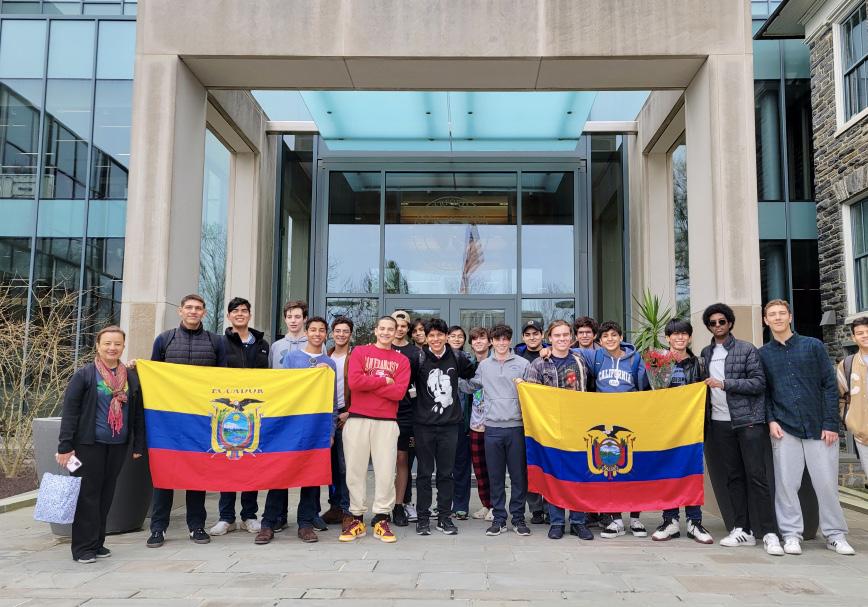
The lack of a concrete schedule allowed students to pursue their interests and investigate all fields of learning.
“I gave them the full schedule of classes they could take, and I tried to disperse them so they weren’t all in the same classes,” Director of Global Studies Mr. Andrew Poolman said. “After a day or two, they decided what classes they liked and what classes they didn’t like and went wherever they wanted.”
Spanish teacher Ms. Susana Lambour believes that this proved beneficial for the Ecuadorian students.
“I like that they were able to choose where they wanted to go,” Ms. Lambour said. “During the first year, we had them follow their hosts around school and it was too much, especially since they’re already living together.”
The Ecuadorian students appreciated the freedom to choose.
“We only have science, social studies, and business at our school,” Colegio Americano student Josue said. “There are a lot of classes within each category, but there are way more classes here.”
Colegio Americano student Mathias ex-
pressed a similar gratitude.
“Here I was able to take classes I really enjoy, like ceramics,” Mathias said. “I really like art, but I had to take a science class over it. I got a chance to try art here, and I really enjoyed it.”
Ms. Lambour also observed that the students wanted to push their boundaries.
“They were all saying that they enjoyed the science classes and classes where they were more challenged,” Ms. Lambour said.
Ms. Lambour and Mr. Poolman both noticed a strong sense of cooperation between Haverford and Colegio Americano students in their Spanish classes.
“In my Spanish IV* class, we were introducing a new topic and the Ecuadorian students were able to understand that everyone’s level of Spanish was good enough for them to speak and be understood,” Ms. Lambour said. “I had a couple of them come to my Spanish II class, and I think they were surprised about the low level of communication skills, but their English was good enough that they were still able to communicate.”
“In my Spanish V* class, we looked at some of the news that was coming out of Ecuador that day, talked about some current events, and did some speaking exercises,” Mr. Poolman said. “They collaborated well. It was good practice to have Spanish guys to speak with them.”
Colegio Americano students felt comfortable in Spanish classes, but other classes in English proved more challenging for some.
“If you know how to speak English, you’ve been learning since you entered school. Coming here to the U.S., it’s like, ‘Woah, I have to speak faster and understand
what they’re saying because here it’s not just a listening quiz that speaks slowly,’” Josue said. “They talk very fast and you have to adapt to how they talk. People have different accents too, and you have to adapt to that as well.”
For Colegio Americano student Nelson, this wasn’t too big of an issue, but he also shared that it could be difficult at times.
“[Speaking English] is normal for me because I’ve been speaking it since I was seven years old, so it’s not too big of a difference,” Nelson said. “It’s hard to understand sometimes, but it’s not that big of a deal for me.”
Despite this language barrier, students from Colegio Americano were still able to collaborate in classroom environments and talk with Haverford students in Spanish and English.
“In my Spanish II class, one day I had [Haverford and Ecuadorian students] ask each other questions before class. One of my students asked an Ecuadorian student a question in Spanish, and he slowed himself down and spoke clearly and slowly so kids could understand,” Ms. Lambour said. “It was really nice to see that they were putting themselves in the shoes of somebody that’s just beginning to learn the language.”
Haverford and Colegio Americano students could hold conversations in English, comparing their lives in dramatically different countries.
“During ASB one class, they were having social conversations, talking about how their school is there and our students asked them many questions,” Ms. Lambour said.
The Ecuadorian students noticed many major differences between The Haverford School and Colegio Americano.
“Haverford is very big, two times bigger than my high school,” Josue said. “Another difference I saw is that here they have a lot more sports than my high school and are very concentrated on sports.”
Mathias noticed the large sports program as well.
“This school is mostly sports, and there are lots of courts and fields with people who are always practicing,” Mathias said. “Back at our school, we have kids practicing sports, but it’s not the main thing.”
The exchange program is not only a great opportunity for Ecuadorian students to get a glimpse of life here, but it also provides a window into life there.
“Hosting was a pretty cool experience,” Fifth Former Sean Ngo said. “You learn about their school life too, and they were super fluent. It’s completely different here compared to Ecuador, and I think they all enjoyed their stay.”
For the Ecuadorian students, this was an opportunity to preview a future life in the United States.
“I signed up for the exchange program because I saw it as a good opportunity to think about my future and see if I wanted to do something with my life here,” Mathias said.
Nelson also sees himself living here in the future.
“It was an opportunity to maybe come live here in the future,” Nelson said. “I want to live a good life around nice people.”
ANDREW POOLMAN
Students from Colegio Americano in Guayaquil, Ecuador standing in front of Wilson Hall MR.
academics the index · academics May 2023 Page 6
Tate Conklin ’24
Model UN attends Cornell, wins a historic award
What do you do when Thanos invades your Model United Nations Conference committee?
To some, Model UN may seem like a very academic-based sport, where knowing facts and going through boring parliamentary debates and procedures is the only way to succeed. Though this may be true for a select number of committees at Model UN conferences, what really matters is quite different.
To do well, at the most basic level, you need to be able to win over other people. Simple as that. Just talking to, making connections with, and collaborating with strangers is the most important thing you can do in and out of committee. It is a great place to learn and grow, and that is exactly what the Haverford team did at Cornell University’s Model UN Conference on April 20-23.
Cornell Model United Nations Conference (CMUNC) is known as a smaller conference, meaning committee sizes are manageable—the perfect environment for beginners to learn.
Haverford usually sends a team of both inexperienced and slightly experienced students to Ithaca, NY, for this conference. Among the students who attended were Third Former Ryan Shams, Fourth Formers Milan Varma, Finn Kelly, Mason Wiegand, and Matthew Yerger, and Fifth Formers David Stewart and Robert Cerniglia. This team comprised different levels of experience—from a single conference under one’s belt to absolutely no experience—but they all shared the drive to succeed.
Unlike conferences like ILMUNC (Ivy League Model United Nations Conference), the committees at Cornell were smaller and therefore more malleable to the individual who took the lead. Haverford adopted new strategies and made new connections to succeed in their respective fields and committees. Cornell had some of the most intriguing conference topics many of Haverford’s delegates had seen before.
Fourth Former Finn Kelly is a firstyear Model UN student participating in his first Cornell conference.
“My topic was about the advancement of women’s rights around the world, also known as the World Conference on Women. I got to represent the country of Israel, which is doing a great job in the world right now in terms of advancing women’s rights,” Kelly said.
Model UN requires you to have a strong presence on your committee.
topic was also really useful, and I came out of the weekend much more knowledgeable and informed.”
Of course, not all committee sessions go the way one would want them to. Things go wrong, like any other aspect of life. But at the very least, Model UN students make connections. These connections may last a lifetime or create strong friendships as you get to know your fellow delegates.
“You get to meet so many cool people. It’s a unique experience in that way,” Kelly said.
Cornell was not only a great experience for the first-time attendees, but it was also a blast for the more experienced students as well. Out of all the conferences of the five experienced members who attended Cornell, this trip had the most unique and interesting crisis committees.
These committees can come in many shapes and forms, but what sets them apart from general assemblies (or GAs) is the pace and crisis backroom feature. In a crisis committee, an event happens that needs to be addressed urgently. Many “directives” or plans for action that get submitted to the backroom are passed, creating a sort of storyline for the participants. In addition, delegates can submit their own personal or joint directive to the backroom to get a secret plan into motion that fits their own interests.
Fourth Former Mason Wiegand touched on this aspect of the teams’ trip up to Ithaca.
glia.
“We’ve had boys win individual awards, but we’ve never won a school or group award, so that’s a historical first,” Model UN coach Mr. Kevin Tryon said.
“I just threw myself into the room, and as my chair (committee leader) said, I had a sway from day one. I also tried to be loud and vocal,” Stewart said.
trying to win an award, try to focus on having fun and getting things done,” Cerniglia said.
You may be wondering where the whole Thanos thing comes in. The most unique committee at Cornell was by far the Marvel committee (though many others come in a close second).
Haverford was also represented in a Marvel-themed committee at Cornell, playing the role of Hawkeye. This committee featured everything from the Sokovia accords, Thanos invading the Earth, characters dying, infinity stones, and Skrulls invading the (actual) United Nations. This committee was the perfect representation of how eventful an academic Model UN conference can be, and how much fun it can entail.
When Thanos invaded the Earth, the Avengers banded together to take his ship down, limited to a brief 20-minute meeting time.
Cerniglia shared similar advice.
“Have a goal and get a head start early on. Also, don’t just try to play the game of
Afterward, characters focused on a variety of paths, with some trying to get power for themselves through the infinity stones while others tried to secure 401k pension plans for retired heroes.
Kelly said, “I got to be a power player in the room, to be honest. There were a lot of countries’ arguments I could really shut down in the room and work to get a resolution passed.”
Not only did Kelly utilize the skills of public speaking and communication, he learned more about this topic and expanded his global perspective.
“[I learned] not just about Israel, but a lot of the other countries as well,” Kelly said. “There were 50 kids in that room, all of whom had done their own research, and as the weekend passed, I got to hear each country’s position on this specific topic. This
“I really enjoyed my committee,” Wiegand said. “It was the AFL-NFL merger in the 1960s. I was the owner of the Rams, and I think what’s really interesting about Model UN is that it’s not just the large committees such as the social humanitarian ones, it’s way more than that, it goes in-depth into niche things… It can be anything, and it throws you into a roleplay situation where you’re not you anymore. You are this character, and it makes you think outside of the box.”
A committee on the sport of football is something that most students wouldn’t think of when they think of Model UN, but these unique committees make the Model UN experience different and fun from conference to conference.
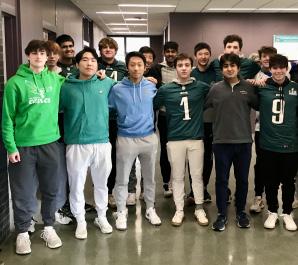
The Haverford team won three awards on this trip: the Best Small Delegation award and two honorable mentions earned by Fifth Formers David Stewart and Robert Cerni-
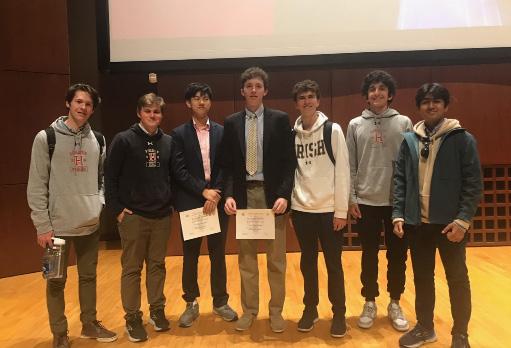
the index · academics May 2023 Page 7
Milan Varma ’25
COURTESY OF ROBERT CERNIGLIA ‘24
COURTESY OF MR. KEVIN TRYON
The Model UN team poses on stage at Cornell Conference
a yearbook
The Model UN team gathers
for
photo
“I got to be a power player in the room, to be honest. I could really shut down in the room and work to get a resolution passed.”
FINN KELLY ’25
“Have a goal and get a head start early on. Also, don’t just try to play the game of trying to win an award, try to focus on having fun and getting things done.”
ROBERT CERNIGLIA ’24
Sensitive issues, cont. from front page
Chair of the History Department and United States History* teacher Ms. Hannah Turlish said, “Students are so young. It’s important to bring in this context to understand the world we’re living in right now.”
Ms. Turlish also connects the importance of political and social awareness to the function of democracy.
to be valid and never telling a student ‘that’s wrong’ in subjective, humanities-based discussions… and letting misinformed, objectively bad ideas run rampant.”
Leader and Dr. Del Rosario see a need for these discussions to combat misinformation, and Ms. Harnett emphasized that teaching sensitive topics provides a complete education.
“It is impossible to teach a text about a Black woman in the South in the 1920s without teaching about these big topics of race and gender,” Ms. Harnett said. “How can I possibly teach my kids to be sophisticated readers of literature if I can’t teach them to be sophisticated readers of context, which are one and the same thing when you’re talking about these specific texts? Students deserve to have a great education. If you’re going to have a great education in American literature, you’re going to need to talk about the controversies in American life.”
The skills that students develop when discussing and debating social and political issues are transferable life skills.
“I don’t think it’s true in anyone’s English class that it’s an either/or where talking about social or political issues is at the cost of disciplinary and literary issues of reading subtext,” Dr. Del Rosario said. “The study of literature, even when you separate it from politics, is fundamentally about how you develop good—meaning nuanced, careful, informed, well-reasoned—arguments about a subjective thing, like a work of art.”
As an aspect of global and American citizenship connected to Haverford’s mission, critical thinking is a vital skill that the school’s liberal arts education aims to foster.

“A responsible citizen should be able to look at the information presented and be able to think about it critically,” Dr. Del Rosario said. “Part of what education has to be is asking students to interact with new ideas and to wrestle with things that they don’t already think.”
to a range of viewpoints. While a different environment would create a different classroom dynamic surrounding these discussions, teachers’ methods don’t necessarily change.
continued on the next page
“Our democracy is not perfect, but it is, in my opinion, the system of government that’s worth fighting for. I think that requires digging into sensitive topics because we are a diverse population of people that has to make it work, and if we’re not talking about the things that make us tense with each other,” Ms. Turlish said, “then I don’t really see us making it work.”
While the weight of these subjects— both because of their sensitivity and their relevance to modern society—might present a challenge, English teacher Dr. Micah Del Rosario believes that students enjoy these topics most.


“Those are the conversations that they find more interesting and fun,” Dr. Del Rosario said.
Students also perceive the importance of these discussions.
Fourth Former Eli Leader said, “I have had teachers who don’t even mention these issues, and I feel like that is something that damages their class. The reason why some of these issues are so sensitive is that they are not being addressed in the classroom, which creates a society that is uneducated about that issue.”
Dr. Del Rosario discussed the presence of misinformation in society that Leader touched on.
“In a world of misinformation… to what extent is it the responsibility of teachers to correct misinformation and objectively wrong views about society and history?” Dr. Del Rosario said. “There is a balancing act and fine line between allowing all opinions
“Everyone has to be sure of what they think and be willing to defend what they think with evidence and sound reasoning,” Ms. Harnett said.
Furthermore, although such topics may dominate some classes’ syllabi, a balance of curricular content remains intact.
Ms. Harnett said, “It’s my job to teach you how to think, not what to think. One of the best ways we learn to think is by encountering world views that are different from our own. What actually makes a good conversation is when you disagree.”
Providing space for unique, differing viewpoints is essential to not only the development of a single idea but also the maturation of students’ ability to think. Haverford provides a unique environment that is home
Dr. Micah Del Rosario stresses the importance of fact-based in-class discussions
“In a world of misinformation… to what extent is it the responsibility of teachers to correct misinformation and objectively wrong views about society and history?”
PIERCE LAVERAN ‘24 the index · academics May 2023 Page 8
DR. MICAH DEL ROSARIO
PIERCE LAVERAN ’24
Students in Dr. Bridget Gurtler’s history class
Sensative subjects, con’t from previous page
Would Dr. Del Rosario change his teaching technique when addressing these issues at a school with different demographics from Haverford?
Dr. Del Rosario said, “I want to say no—if I were at a school that had a different political leaning than Haverford generally has (obviously there are lots of different people who think lots of different things), I would still make some of the same moves I make in the classroom, like asking the provocative, agitating questions that force the students to wrestle with a counterargument.”
Comparing Haverford to her previous place of employment—an all-girls private school in Manhattan—Ms. Turlish said, “Here, I feel it’s a bit more exciting in that kids tend to be more evenly split in a way that makes it very engaging in terms of dialogue. There’s more diversity of ideas in the room that are being exchanged freely which makes it more fun.”
emphasize the importance of diversity of thought and perspective and openness to all viewpoints, certain ideas can be hurtful—intentionally or not.
Teachers stress ground rules for class discussion, which allow students to say what they think unless their comments directly target another student in a hateful manner.
“Disagreeing with somebody doesn’t mean that they shouldn’t speak in the first place,” Ms. Harnett said. “Something I’ve noticed is that I do think my students feel comfortable sharing their honest opinions with each other, and they’re not worried that someone’s going to cancel them, so they speak.”
Ms. Turlish acknowledges the role her students play in managing conversations.
“I have been really impressed by how oftentimes, these kids, by the time they get to me as juniors, call each other out. I don’t have to say anything,” Ms Turlish said. “I’m certainly aware that you want kids to feel like they can say whatever’s on their minds, but also some things that come out can make other kids feel unsafe… We can’t assume that every kid can know what would be perceived as hurtful to others in the room.”
While teachers bring experience with holding serious dialogues about sensitive topics, the true experts in what may be hurtful are those to whom specific content is personal. Neither Dr. Del Rosario nor Ms. Harnett nor Ms. Turlish change their curricula based on the demographics of their classes.
Dr. Gurtler, whose class Science, Sex, and Culture* covers topics of sexuality
if something is okay to say and it isn’t the biggest deal. It’s never a good feeling to be singled out in a class for something sensitive that is about to be discussed, which in most cases is race-related.”
bias that I wasn’t acknowledging.”
Ms. Harnett also raised the importance of standing up for one’s convictions. “A really important life skill is to learn to not only challenge your own beliefs but to challenge an authority figure’s belief in a respectful way,” Ms. Harnett said. “Given that my worldview is often so different from my students, that actually creates a great opportunity in the classroom to teach my students to challenge authority.”
Ms. Harnett’s reference to differing world views or opinions raises the challenging question surrounding sensitive discussions in the classroom. For an issue to be considered “sensitive,” it must affect someone on a personal level. And while teachers
While Dr. Del Rosario feels that lessons should, perhaps, be adapted based on classroom demographics, he is wary of the assumptions that would have to be made. “Should you edit the lesson based on who’s in the room? Yes. The trick of that is that I don’t want to make assumptions about people, just based on their physical appearance… I’d rather treat everyone the exact same,” he said.
Although none of the interviewed teachers tailor the curriculum based on classroom demographics, students have experienced instances of such adjustments at school. Fifth Former Arsh Aggarwal said, “I have had teachers do this with me before, where in front of the entire class they’ll ask
Aggarwal also questioned whether a teacher should ever teach with a bias. He explained that when going over a massacre, a teacher suggested there could be justification for atrocities.
“On one hand, I think it is fair to consider all sides of an event. In fact, I probably would vouch for that… the class is heavily selectively sympathetic, and it seems like in a subject where objectivity is so crucial… I feel like it’s failing us.”
With students’ concerns about bias in mind, the teachers interviewed acknowledged that leaving space for all opinions and voicing their own is appreciated.
“Something I noticed very early in my career is that kids hate [when teachers keep points of view and political values to themselves],” Ms. Harnett said. “It makes them suspicious. To some degree, it felt like I was tricking them, that I had some agenda or
Ms. Turlish said, “I get the whole ‘teacher not betraying his or her point of view,’ but when it comes to the civil rights of the people in my classroom, I do think it is important for there to be a voice of authority that is… putting out the historical facts.”
Dr. Del Rosario allows students to express themselves but also finds that it is important to challenge certain lines of thought.
“I let people make their arguments, but if someone says something that I think is objectively wrong and crazy, I’m going to fight them on it, because I think that that’s part of my responsibility as a teacher—to try to show students holes in their reasoning,” he said, demonstrating the relevance of these topics to general critical thinking skills and global citizenship.
While students may react differently to certain classroom strategies, students feel and teachers recognize that it’s vital to discuss sensitive topics in their classrooms— places where they can challenge ideas and learn to think for themselves.
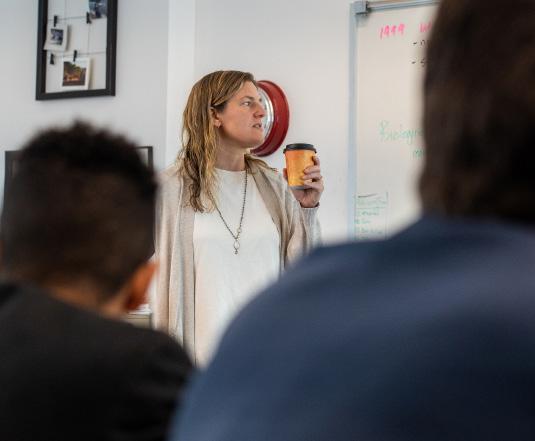
Classics students attend Penn’s first Certamen
Have you ever wondered which group of warriors Achilles led or what derivative of the Greek noun for “child” refers to the practice and study of teaching? I thought so.
These questions and many more were answered at the 2023 University of Pennsylvania’s first Certamen, the literal translation of which means “competition.”
On Saturday, March 18, Haverford students joined 30 other schools primarily from the Northeast to engage in multiple rounds of Certamen, a classics quiz-bowl competition for students of Latin, Greek and classical civilizations and their relationships to the modern world.
Despite Haverford’s team not finishing as high as they had hoped, students fought hard at this year’s first Penn Certamen, perhaps creating a new tradition.
In Certamen, students test their knowledge of mythology, classical history, culture, and all things Latin, as they answer questions created by other students.
Classics enthusiasts have few opportunities to collaborate and test their knowledge of the ancient world. There are individual assessments where students can participate, such as The National Latin Exam, The National Greek Exam, and The National Mythology Exam, but these individual assessments are no different than taking an exam at school. Certamen is unique and collaborative—comprised of a team of like-minded peers.
“I think that Certamen has a lot of po-
tential at Haverford,” Fourth Form Certamen student leader Phineas Manogue said. “We have an abundance of bright students who are interested in classics, not to mention all of our great Latin teachers.”
Competitive Certamen runs in three divisions: Novice, Intermediate, and Advanced. At Penn’s Beginner Certamen, however, the target group of participants was students who were classics enthusiasts but who had not formerly competed in Certamen. Penn Certamen offered both Novice and Intermediate divisions, with The Fords competing in the Intermediate level.
Last October, students were given a Certamen Starter Kit, a six-week syllabus with practice questions. Haverford students tested the waters with a practice scrimmage with The Baldwin School in January.

“Penn was the only organized tournament that we could compete in this year,” Manogue said. “Luckily, we have been able to have friendly one-on-one competitions with Baldwin and hope to have another scrimmage involving more schools soon.”
To prepare for Penn Certamen, however, students dove deeply into the syllabus to study tricky material. From then on, Manogue kept students’ minds focused on all things classics in weekly Certamen club meetings.
Led by Latin teacher Dr. Andrew Fenton, Fourth Formers Phineas Manogue, Harry Koenig, and Nicholas Lu, and Third Former Grayson Morgan—comprised the first group of students to attend the contest.
Colleges across the country such as Stanford, Harvard, Yale, and Princeton, have hosted high school participation in Certamen contests, but this was Penn’s first foray into the competition.
The group concluded their day with a group lunch in which they reflected on the contest.
“After the tournament at Penn, it was clear that the spirit of competition ignited some enthusiasm amongst the team,”
Manogue said. The group’s attendance and enjoyment of the Certamen will likely create optimism for Haverford’s Classics teachers, as they hope to bring an even larger and better-prepared group of students next year.
“Next year, I hope to get a team organized for Yale in November,” Manogue said. “I am [also] excited for Penn in March, when we might have enough interest to send multiple teams.”
the index · academics May 2023 Page 9
“On one hand, I think it is fair to consider all sides of an event. In fact, I probably would vouch for that.
PIERCE LAVERAN ’24
ARSH AGGARWAL ‘24
Grayson Morgan ’26
DR. ANDREW FENTON
Harry Koenig ’25, Phineas Manogue ’25, Grayson Morgan ’26, and Nicholas Lu ’25 at work in the Certamen Competition at Penn, March 18, 2023
neighborhood
The Clay Studio: the center of ceramics in Philly
Ethan Lee ’24
Since its founding, the city of Philadelphia has acted as a hub for many different occupations. In the world of ceramics, The Clay Studio, located in Philadelphia, is both a powerhouse and the capital of ceramic art in the area.
Originating in 1974, The Clay Studio began as a way for artists fresh out of art school to have workspaces where they could experiment and work with ceramics at an affordable price. This soon evolved to a more community-based mentality that focused on engagement and education.
Currently The Clay Studio acts as the center point for ceramics in the area. Resident artists provide classes for the community free of charge, and the studio hosts exhibitions where artists can display their work.
“[The Clay Studio] started as an artist residency/studio space but then evolved to do ceramic classes and a lot of outreach programming, bringing clay programs to schools that don’t have them,” said Ms. Stephanie Kantor, 3D Art teacher and current resident of The Clay Studio. “It’s kind of a ceramic powerhouse that does a ton of advocacy for the ceramic arts.”
Some Haverford students have used The Clay Studio’s resources.
“The Clay Studio works with my sister’s elementary school often,” said Fifth Former Amir Ibrahim, who lives in close proximity to the studio. “They bring clay and teachers to her school, and they encourage the kids’ creativity by teaching them how to mold plates, faces, and a few other things. Just from listening to my sister and seeing the art she brings home, I can tell how much she enjoys working with The Clay Studio for her projects. It’s definitely boosted her creativity and willingness to create some of her own things.”
Residencies in The Clay Studio are extremely competitive: out of about 90 appli-
cants, only two were offered studio space in the most recent residency cycle.
“The importance of The Clay Studio in the Northeast cannot be understated,” Ceramics teacher and former Clay Studio resident Mr. Jacob Raeder said. “A lot of times people find professional jobs and studios through The Clay Studio, as everybody in this area asks The Studio for recommendations for artists.”
On average, residencies are about five years long, giving artists fortunate enough to get studio space time to settle down in the Philadelphia area.
“For me, it was the reason I came to Philly in the first place,” Mr. Raeder said.
Artists that get residencies not only get free studio space to work on various projects but also teach classes to the community. The commitment is time-consuming.
“My first two years at The Clay Studio
ist means that you have a job outside of your practice,” said Mr. Raeder. “The residency is an incredible opportunity because of how free form it is and how it accommodates a lot of different styles and schedules of making.”
As many artists at The Studio are fresh out of art school and looking to jumpstart their careers, The Studio also acts as a place where they can congregate with others at similar points in their lives.
“When I was there, there was a ‘professional club’ aspect to the residency,” Mr. Raeder said. “Even though your colleagues are not doing the exact same work as you, they are at the same time of their lives where they are building foundations.”
Recently, Mr. Raeder presented an exhibition with his artistic practice Better Lovers through The Clay Studio. Currently, Ms.
Kantor is working towards an exhibition that will take place in July.
The Clay Studio is located in Kensington and is easily accessible by the public.
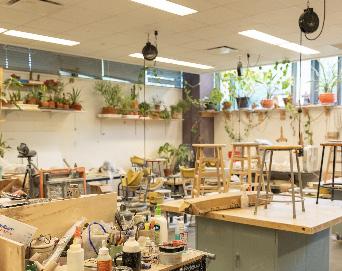
“The same as Mural Arts, [The Clay Studio] has a lot of credibility,” Mr. Raeder said. “I wish that our students take advantage of the incredible opportunities that are really just 30 minutes away
Ms. Kantor agreed.
“There is this wealth of opportunity if people are interested in arts in general [in Philadelphia],” Ms. Kantor said. “There are a ton of resources that seem distant, but once you visit, everyone is very friendly and just trying to share the love of art.”
I was not working [at Haverford], so I was working in my studio from 9-5,” said Ms. Kantor. “Now that I have been working here, a lot of time management is needed to balance my work here and at the studio.”
The Clay Studio is flexible when it comes to their residents working. Residents have 24-hour access to the studios.
“Because people are coming from all parts of the country and now internationally, there is recognition that to be a working art-
Nate Mirin increases biodiversity in the neighborhood
If you listen to student announcements at assemblies, you have heard
Sixth Former Nate Mirin talk about Tree-Plenish. Addressing the upper school, Mirin invites students to go out and plant trees.
“Tree-Plenish is an organization which looks to help high schools basically manage tree planting events,” Mirin said. “It is a completely college and high school studentrun non-profit, which looks to do every part of the process. First, they try to get grants to help pay for [the event]. Then, they work with the outreach program in order to try and help get the word out about the program to as many schools as possible before also providing logistics and actually ordering the saplings for the events.”
Mirin stumbled upon the organization when applying for an internship.
“About a year ago, I applied for an internship through Tree-Plenish, and I was lucky enough to be selected,” Mirin said. “I’m currently on their outreach team, and I’ve been that way for about a year or so after learning about it. And, through the internship, I’ve brought it to Haverford.”
Tree-Plenish originated from a Massachusetts high schooler’s senior project.
“Five years ago in 2018 or 2019 there was one local school up in Massachusetts.
A student said, ‘Hey, we should have a tree planting event.’ It caught on with the local community, and it’s just sprouted out ever since,” Mirin said.
And sprout it has: according to Mirin, the group has had an immense impact on the U.S. and abroad.
“So for Tree-Plenish, as of this month we’re international. We did a program in Nigeria. But it’s all over the world and all across the country,” Mirin said. “There are ones in California, Texas, Wyoming, a whole bunch of the Northeast, South, Southeast, Northwest, Midwest. It’s solid wood country.”
“So at the Haverford School’s event, we were able to give away 300 trees. Over 300 schools have been part of [the group], and in just 2022 alone, they have planted nearly 50,000 trees.”
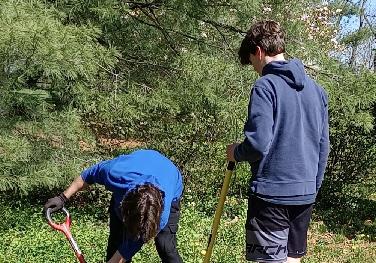
Mirin referenced believes in the importance of biodiversity.
“I mean, I really enjoy working with the environment, trying to increase biodiversity in the local area, especially in urban and suburban areas where the biggest green space is frequently just grass. So definitely trying to increase the biodiversity and trying to plant more trees, because trees have a huge variety of benefits: less AC usage, more wanting to be outside,” Mirin said. “It’s also just prettier landscaping, to be totally honest.”
Ultimately, Mirin hopes this year’s tree planting event can become a school tradition.
“This doesn’t have to be a one-year event,” Mirin said. “There’s definitely a demand for this program to continue on for years to come, so just keep working at it, since I know there’s a lot of people who we
had to turn away from trees as we just didn’t have enough. So definitely if in the future, we can continue this event, that would be awesome both for our school’s impacts to positive changes in the local community and also just to help out the environment locally.”
the index · neighborhood May 2023 Page 10
Luke Ganley ’25
PIERCE LAVERAN ’24
Mr. Jacob Raeder’s ceramics studio on Wilson Hall’s ground floor
TREE-PLENISH
Students plant a tree as part of the Tree-Plenish program
“There is this wealth of opportunity if people are interested in arts in general [in Philadelphia].”
MS. STEPHANIE KANTOR
When I enrolled in Honors Chemistry, a notoriously difficult class, I expected lots of homework and late nights. What I didn’t expect was a lesson in the importance of balance.
On a blustery cold day in January, Chemistry teacher Mr. William Leech, along with Chair of the Science Department Dr. Daniel Goduti, called students outside.
Chemistry’s life lessons
demonstration is what happens when there is no counteraction to pressure.
As I shivered in the cold watching the demonstration, I realized that not only was this a lesson in the relationship between temperature and pressure, it was a perfect analogy to the importance of balance in our own lives.
Balance is a condition where different elements are equal or in the correct proportions. The steel drum collapsed when the relationship between the pressure inside the drum and outside the drum were no longer in the right proportions, no longer balanced.
As students, we often feel the most pressure when the relationship between expectations and capacity are not in the right proportions, when what we need to do and what we feel we have the time or desire to do are out of balance.
and show theme, my classmates and I had to learn actual circus skills.
walking globe and, of course, ride a unicycle. The unicycle was the biggest challenge; it was weeks before I stopped falling.
We found our teachers in long white lab coats and brightly-colored, heavyweight protective gloves. Clouds of steam rose from a 12-gauge, 55-gallon steel drum set upon a burner. A blue ice bath sat on the ground next to the drum.
“When it comes to gasses,” Mr. Leech declared, “everything is based on relationships.”
In the demonstration, a small volume of water inside the steel drum was heated to boiling point, then the drum was sealed and placed directly into the ice bath. As the temperature inside the drum cooled, the pressure decreased and the atmospheric pressure on the outside caused the drum to implode.
What we witnessed in the chemistry
For months we learned how to juggle, walk a tightrope, perform aerial tricks with the Spanish web, move effortlessly on the walking globe and, of course, ride a unicycle.
The first time I ever thought about balance was in fourth grade. As part of a yearlong project, my class put on a circus. In addition to planning the logistics, budget,
For months we learned how to juggle, walk a tightrope, perform aerial tricks with the Spanish web, move effortlessly on the
The concept of balance is easily explainable, as Mr. Leech and Dr. Goduti showed us. And the consequences of not balancing pressures are easily demonstrable, as we all saw with collapsed steel drum. But teaching someone to find balance for themselves is almost impossible. Just like in riding a unicycle, you have to put in the work to figure it out for yourself.
An unexpected life lesson from chemistry class is that if you don’t find the right balance, the pressure can be crushing. But putting in the work to find the equilibrium between internal and external pressures might just be the key to surviving the pressures of high school.
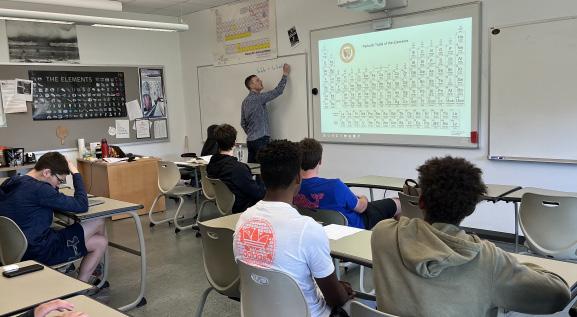
Should college counseling start earlier? No.
Should college counseling start at the beginning of Fourth Form?
Considering the record low acceptance rates in colleges this year, some students say yes. Applying to colleges is a stressful process for everyone. Having someone there to guide you through the process is beneficial, but will starting the process earlier help or hinder students?
How many students can one counselor reasonably take on at once?
Fourth Formers are assigned their college counselors in the spring. Yet some students feel the stress of the college process much earlier than spring of sophomore year. But are our college counselors prepared to deal with another class of students a year earlier than they do now? Might the urge to start early take time and resources from the
Fifth and Sixth Formers who are deeper into the process? How many students can one counselor reasonably take on at once?
Let’s say there are one hundred and twenty students in each grade, and we have four college counselors. With our current system, that’s 60 students across two grades per counselor. If we were to add another grade to the list, it’s 90 students per counselor. That’s a 50% increase. Is that manageable or fair to students or counselors?
Perhaps a better question is: are Fourth Formers feeling the stress which accompanies college applications yet?
Perhaps a better question is: are Fourth Formers feeling the stress which accompanies college applications yet?
According to Fourth Former Finn Kelly,
“Yes. A lot of my friends have put themselves into more communities than they should or want to, just for the point of saying, ‘Oh, it’ll look good for college.’ Which is kind of bad, in my opinion.”
But Fourth Former Liam French offers a different perspective, “I don’t honestly care when [college counseling] starts. It’s just that parents put the most pressure on their kids, in my opinion.”
While several Fourth Formers note feeling stretched and feeling some stress, there is no consensus about whether starting the college counseling process earlier will help.
“I feel some stress with classes. I just do extracurriculars because I enjoy them,” Fourth former Mason Wiegand says.
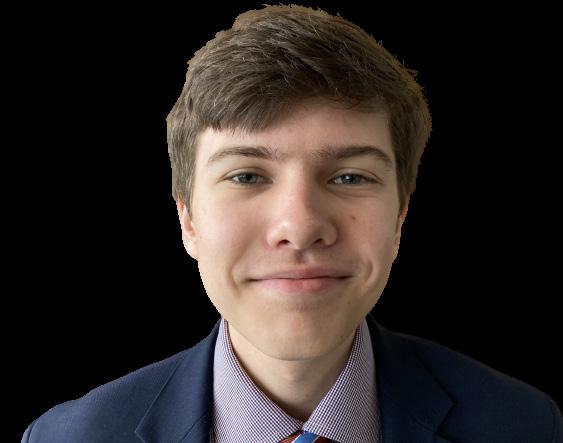

“You just get overstretched,” French said. “It’s a lot to do all at once, but it just takes a lot of time management.”
But couldn’t our amazing college counselors help with this time management?
While each Fourth Former I interviewed had a different opinion on when the college counseling process should start, they
all shared anxiety over topics our college counselors would likely be able to provide insight into.
Though a specific college counselor is not assigned until Fourth Form spring, the counselors are always available to answer questions. A quick email or stopping into the college counseling office may be all that is needed to ease a concern.
Obviously, we can all benefit from a little extra help, but our college counselors can only do so much. Because of this fact, it is probably best that we stick to what we know and keep the current college counseling system.
Luke Ganley ’25
Connor Simpkins ’25
IAN
campus
the index · campus opinions May 2023 Page 11
Mr. William Leech teaches a chemistry class
ROSENZWEIG ’25
opinions
When it comes to gasses, Mr. Leech declared, “everything is based on relationships.”
But putting in the work to find the equilibrium between internal and external pressures might just be the key to surviving the pressures of high school.
A quick email or stopping into the college counseling office may be all that is needed to ease a concern.
If you want a cesspool of human discourse, look no further than Twitter. While humans have always had the propensity to say mean things, we are now seeing more and more instances of humans hurling verbal daggers at one another. Cliques and cancel culture are commonplace across social media and even on the traditional news sites.
Fighting polarization in the classroom
ity of this statement was put into question by many Twitter users due to the lack of blue checks indicating verification on the platform. A verified Ted Cruz account then replied by citing all of his blocked gun restriction laws as the culprit of the shooting, despite the fact he was not the real Ted Cruz.
Few people would use positive words to describe Twitter. For many, the words “Wild West” might enter our brains. Since Elon Musk became the CEO, the use of foul language has risen over 700%. Yet the user base has grown.
According to a report from NBC News last year, the largest culprit of this growth was the morbid curiosity of people who just want to see what new forms of verbal torture Twitter users would inflict on others.
So what is happening on Twitter? According to Elon Musk, free speech.
formed than they think they are. Misinformation can have dire side effects. Oftentimes, teenagers are exposed to false headlines on all social media platforms. Parents fall victim to this as well. Dr. Del Rosario says that sometimes students will blindly trust their parents or friends even if the information they received is proven false.
It can, at times, be easier to default to old opinions than it is to evolve our understanding into something new.
“It is natural for a teenager, when they are challenged, to respond in a way that may not be receptive to that challenge,” Head of Upper School Mr. Mark Fifer said. “That’s kind of the default position.”
Mr. Fifer thinks students may not be totally to blame for this.
learn to live in doubt, yet based on scientific reason.” This process is something that students must take into their own hands.
Sixth Former Colin Kelly does not believe that all students have to be deeply invested in every societal issue they are exposed to in class, but does believe that Haverford gives students plenty of tools to be more informed, from the school-issued New York Times subscriptions to thoughtful teachers that encourage conversations outside of class. No matter how you look at it, the culture of bias, misinformation and misplaced pride found in society has affected our classrooms. Whether it comes from Twitter, parents, or other sources, students have been greatly affected by the oversaturation of information.
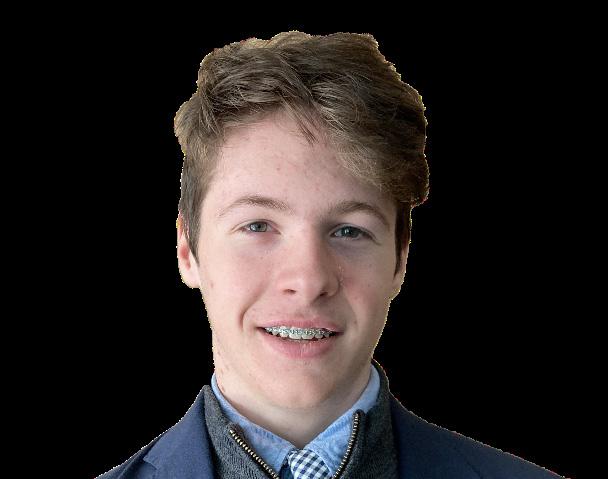
The trend toward bias, misinformation, and misplaced pride has also found its way into our classrooms. It is up to students to prevent it.
One example of this dangerous misinformation was showcased during the horrific shooting at the University of Virginia last year. The campus released a Tweet telling all students to remain indoors. The valid-
Humans’ propensity to argue can also be found in the classrooms of Wilson Hall. According to English teacher Dr. Micah Del Rosario, “There is a level of excitement in arguing which students enjoy…I wish there was the same level of interest when it comes to reading a hand-out or an article where students are presented with facts.”
Dr. Del Rosario also notes the nature of students to “argue for the sake of arguing,” despite the fact that they often are less in-
“There is polarization of our world…of people being put into camps and information being funneled to the general population that makes it harder for people to engage in oppositional views,” Mr. Fifer said.
The connection of people through dialogue has been disrupted in society today. So what can students do to prevent polarization in our classrooms?
Mona Weissmark, a clinical psychologist and a visiting professor at Northwestern University and Harvard University, recalled a quote from her own professor, “We must
School should start after 8:30
Knowing how to think and navigate narratives and to find tangible facts and solutions are key traits students should strive to find. Haverford, according to many faculty, gives students the opportunities to build these traits.

A red line has been drawn for students between informed thought and continued ignorance.
The greatest question we must ask ourselves is: which side will they choose?
Have you ever woken up for school and wanted to go back to bed? I guarantee the answer is yes. In the United States, schools have traditionally started at around 8:30 a.m. However, there is growing evidence that this is not the best time for school to start.
Many teenagers struggle to get enough sleep. The American Academy of Pediatrics recommends that teenagers between the ages of 14 and 17 should get between eight and ten hours of sleep per night. However, many teenagers fall short of this recommendation.
One reason for this is that the body’s natural sleep cycle shifts during adolescence. Teenagers tend to feel more alert in the evening and may struggle to fall asleep before 11:00 p.m. As a result, getting up early for school can leave them feeling tired and groggy, which leads to a subpar school experience.
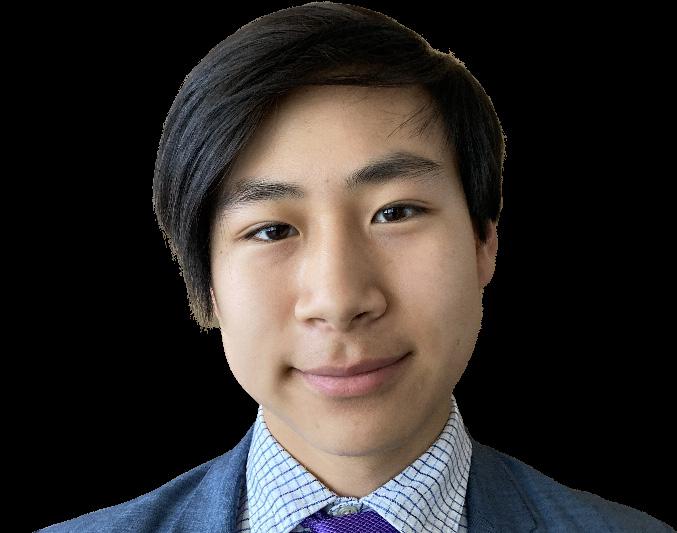
Lack of sleep also has a negative impact on academic performance. Studies have shown that students who get enough sleep perform better academically than those who don’t. When students are tired, they may
struggle to concentrate and retain information. They may also be more likely to make mistakes and take longer to complete tasks.
Sleep loss can impact teachers too. In fact, at Haverford, teachers are at school far earlier than students. If we were to start school later, teachers would also be able to rest and have more energy when they teach their students.
Starting school later could also have positive impacts on students’ mental health. Lack of sleep has been linked to anxiety and depression in teenagers. Giving students
more time to sleep could help them feel more rested and relaxed, which could in turn improve their mental health.
Starting school later could benefit families in many ways. Parents who work long hours may find it difficult to get their children to school early in the morning. Starting school later could make it easier for them to drop off their children on their way to work. It could also give families more time to spend together in the morning, such as eating breakfast together.
School starting after 8:30 could provide many benefits for students and teachers alike. It is time for schools to consider changing their schedules to better meet the needs of their students and families.
 Ryan Hu ’26
Ryan Hu ’26
the index · campus opinions May 2023 Page 12
Mason Wiegand ’25
The trend toward bias, misinformation, and misplaced pride has also found its way into our classrooms. It is up to students to prevent it.
A morning outside Wilson Hall
PIERCE LAVERAN ’24
off-campus opinions
Don Lemon and Tucker Carlson were fired. Will they be canceled next?
Journalism itself has dominated the news for the past several weeks. Two of the industry’s top anchors, Tucker Carlson and Don Lemon, were abruptly fired by their respective organizations.
Both were removed after disparaging and distasteful comments, some of which had previously surfaced.
While their removals remain distinct, both spur the same question: will they be canceled?
Tucker Carlson closed his April 21st broadcast by telling his viewers he would “be back on Monday.” Little did he know, that would be his final broadcast.
Carlson became America’s mostwatched news anchor, after spending several years with notoriously right-wing Fox News. Carlson grew increasingly well-known for being one of President Trump’s top advocates. After years at the mountain-top of opinion-based journalism, Carlson was unexpectedly terminated on April 24, 2023. Fox did not disclose a reason for removing their top news anchor. The New York Times later reported on a cryptic text message sent by Carlson after the events of January 6th. In the message, Carlson described a video he saw depicting three white men viciously attacking an Antifa member. The most incriminating line of the text reads, “It’s not how white men fight.”

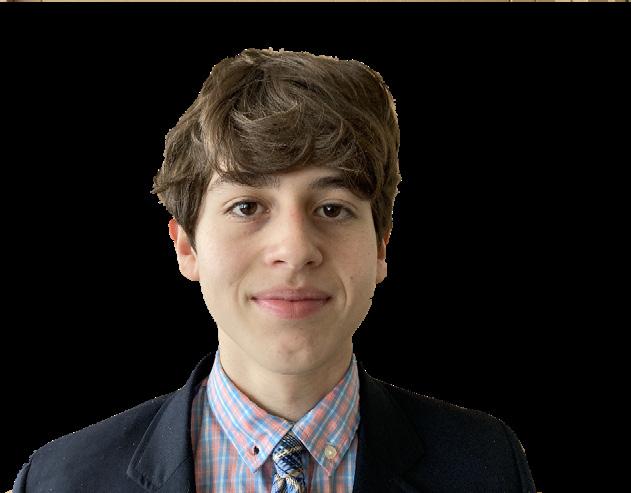
But this was not Carlson’s first time in the spotlight for making racially insensitive comments. Carlson once opened his broadcast by claiming immigrants make this country “poorer, dirtier, and more divided.” Additionally, a recording surfaced of Carlson referring to people in Iraq as “semiliterate primitive monkeys.” It seems Carlson’s history of offensive and derogatory comments had finally caught up with him. Carlson was a ticking time bomb, and Fox finally realized they had to defuse the bomb.
Fox’s left-wing counterpart, CNN, similarly fired one of their top anchors. Don Lemon was fired the same day as Tucker Carlson. Lemon made distasteful remarks toward women. While discussing the prospect of Nikki Haley becoming president, Lemon claimed she was “not in her prime.”
Lemon also claimed that women are in their prime in their “twenties, thirties, maybe forties.” Lemon tried to defend his sexist utterances by saying, “Don’t shoot the messenger, I’m just saying what the facts are.” Lemon later apologized for his words.
Make no mistake, the comments made by Lemon and Carlson have no place in the media. Carlson’s words were blatantly racist, while Lemon’s were rather ageist and sexist. Both Fox News and CNN made the right call by firing them.
It is becoming a more common sight to see someone “canceled” after making offensive comments. However, navigating cancel
AI, too artificially intelligent?
Most of us think the apocalypse is millennia away, but it is approaching faster than you can imagine.
Technology is constantly improving, and with that, large companies are producing new forms of artificial intelligence (AI). These new forms of AI, however, are not ones we may be familiar with; instead, their algorithms are becoming so advanced that not even the companies are fully familiar with their own products.
A prime example of this would be the infamous Open AI’s ChatGPT, one of the most technologically advanced publiclyavailable forms of intelligence we’ve seen. The tool has the ability to process and subsequently respond to pretty much any question or prompt, whether it be, “Write me an essay on World War I,” “What is the theory of relativity?” or even a question as simple and open-ended as “How are you doing today?”
It can even process and answer in various languages, assess, edit, and read pieces of literature, and respond at different age levels. ChatGPT is essentially endless; it’s extraordinarily difficult to tell the difference between
the writings of an educated human and the AI, and the most frightening idea is that it is only continuing to get more and more advanced, learning with every human input.
is to eliminate all humans. The next step is to give it a functioning body and do the same to more just like it, and the rest will be history…
A new website by the name of “Pim Eyes” was recently deemed the most frightening on the internet by Reddit users. Its algorithm was coded in a way that, when you take a picture of yourself and submit it, it automatically searches the web for all pictures ever taken of you—yes, it works!
Slightly less disturbing, another Twitter user was able to produce an AI-generated
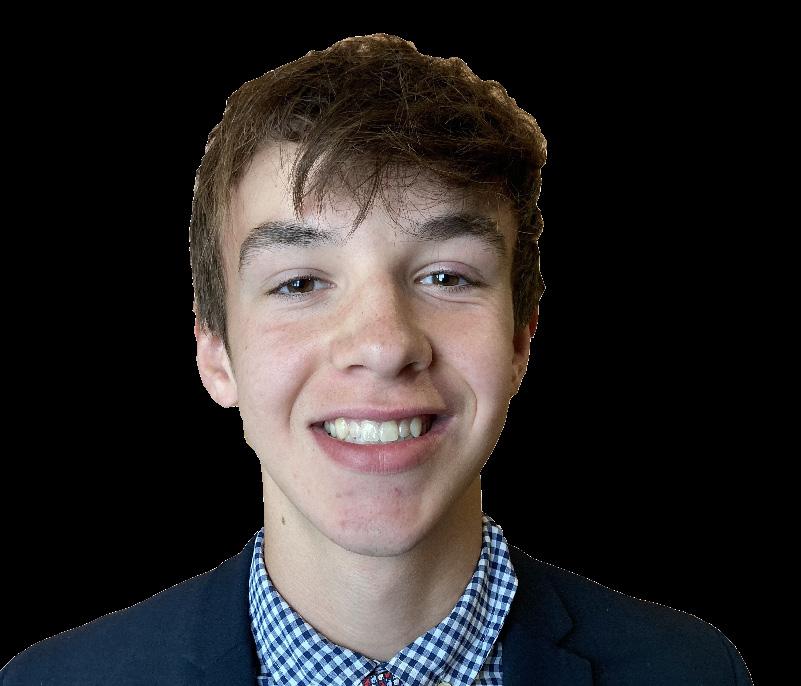
culture can be quite difficult. Kanye West may be the most deserving person to be canceled, after making highly anti-Semitic remarks earlier this year. However, his music is still played all across the country, even in Wilson Hall.
Though Chick-Fil-A is widely considered to be canceled, it still hauls in the highest profit-per-store margin in the country. It is quite easy to declare something canceled, but when it actually comes time to cancel something people back down.
Though Lemon and Carlson both deserve to be canceled, they most likely will not.

Another, slightly simpler form of GPT (generative pretrained transformer) AI is Chaos GPT. Chaos GPT was developed by a Twitter user, and its algorithm was developed to take the “mind” of an apocalyptic being striving for death to all humanity. Even though it cannot actually achieve this goal (yet) because it is simply a text-producing bot, there is something eerie about how it writes that the only way to save the Earth
song which was a “collaboration” between popular artists The Weeknd and Rihanna. The results sound scarily accurate.
The rise of AI technology is both an exciting and concerning development. As AI continues to advance, it is expected to replace millions of jobs, which will undoubtedly have a significant impact on society. Likewise, the recent departure of Geoffrey Hinton, known as the “godfather of AI,” has also warned the population and raised concerns about the direction in which AI is heading. While AI has many benefits, including the creation of language models like Chat GPT (which Hinton is partially responsible for), we must be aware of the potential dangers it poses. It is important to approach AI with caution and continue to explore its limitless possibilities while also acknowledging and mitigating the risks. Ultimately, the future of AI will depend on how we choose to develop and use it.
One way in which I chose to use AI was to have Chat GPT write the previous paragraph you just read.
Be careful, be aware, be wise.
Tommy Saul ’26
Colin Toth ’26
De-
GAGE SKIDMORE VIA WIKIMEDIA COMMONS
Tucker Carlson speaks at Palm Beach County Convention Center on
cember 22, 2018
the index · off-campus opinions May 2023 Page 13
As AI continues to advance, it is expected to replace millions of jobs, which will undoubtedly have a significant impact on society.
Chaos GPT was developed by a Twitter user, and its algorithm was developed to take the “mind” of an apocalyptic being striving for death to all humanity.
On April 27, Head of School Mr. Tyler Casertano spoke to the Sixth Form after an assembly. He mentioned “senioritis,” lack of attendance, and failure to meet expected standards. He urged us to end our final year on a strong note, with punctuality and respect, emphasizing that our legacy as an entire class gave younger students an image to look up to. Amongst the advice given, he posed a question: “How do you all [the Class of 2023] want to be remembered?”
Now, while I reflect on my years at Haverford, my mind drifts to how little time I and the Class of 2023 have. The date as I am writing this article is May 6, 2023—six days until May 12, 2023, the last Friday before graduation projects begin and the end of our time taking high-school courses.
And so, I return to Mr. Casertano’s talk.
How do I want to be remembered?
Scattered around Haverford are remnants of transformative community members. Buildings such as Wilson Hall, Severinghaus Library, and Crosman Hall (the former middle school building) honor the legacies of previous Head of Schools. More recently, students like former student body president Mitav Nayak ’22 and Jeffrey Yang ’22, both active student leaders during their Haverford career, have shaped the way cur-
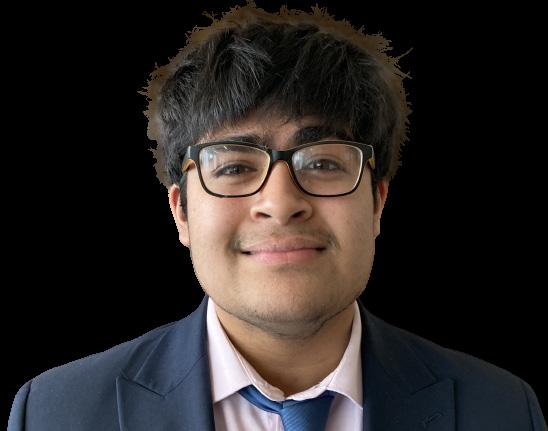
rent upper schoolers act through their previous initiatives, involvement in student activities and clubs, and immense presence at school.

er community. And while I wish I pushed myself to enter the spotlight more often, I do not regret the career I’ve built in upper school. Through the conversations I’ve had and the relationships I’ve established, I believe I have been able to help someone else smile.
I think that’s okay.
Most legacies will not be defined by the tangibles. It won’t be through the number of rules someone changed or the roles they had. Like all things, our memory will gradually fade into the background, becoming just another statistic of “the Class of 2023”.
Perhaps those small moments or conversations we had with someone else in the community inspired them to pursue a passion, idea, or goal of theirs.
Or maybe not.
Maybe that person simply enjoyed spending time with us, which I believe is outstanding.
If my legacy is solely marked by the everyday interactions I had with others, then I’m glad.
But I’m not like them.
And most people aren’t. Only a handful of people have such significant impacts on their community that they are commemorated for years to come. It’s only inevitable that the vast majority are forgotten, right?
I may not have produced the most change during my time here. Rather than attempt to improve the school on a grand scale, I spent my time finding my place, building smaller relationships, and learning about those around me. Along the way, I’ve had potent conversations and shared intimate stories, all of which have led me to gain a better understanding of myself and the larg-
But if one person was affected by our presence, maybe an underclassman or teacher, then maybe we can be more.
If that’s the case, then I know my commitment to those around me had a lasting impact. And if that impact, no matter how brief, was able to improve someone else’s day, then it certainly wasn’t a waste of time. I would dare to call it important too.
Optimistically, I believe that those brief moments can forge a culture where people can freely share and smile with each other, ultimately cascading into a friendlier, healthier, and better Haverford—a naturally imperfect place that persistently strives for improvement through its collective, uplifting student population, a place we can proudly say we were a part of regardless of who remembers us years from now.
One view of the French pension reform crisis
How big of a deal is two years? This is the question that piques the interest of the world regarding the ongoing protests in France.
French President Emmanuel Macron recently passed a motion that raises the retirement age from 62 to 64. The bill would significantly cut governmental pension costs by a significant amount. What is strange about this situation? There was no threat to bankruptcy for the French pension system, so why need it in the first place?
The bill has been widely unpopular, but
some government officials have been trying to pass it for years. The majority never voted to pass it, but due to a loophole in the French constitution, Macron was able to pass the law without a vote.
France is a welfare state, all of the citizens accept extremely high tax rates of up to 45% in exchange for pension security. Essentially, they are keeping some of their tax money for later in life. The French people make sacrifices so that they can enjoy their lives when they are older. “The French way” is to start your working career early, and re-
tire when your body is still capable of doing things such as traveling. Many people have given up freedoms in their early adulthood to work, and this is the premise of the people’s outrage. The disconnect between the governing body and the citizens is what angers many French.
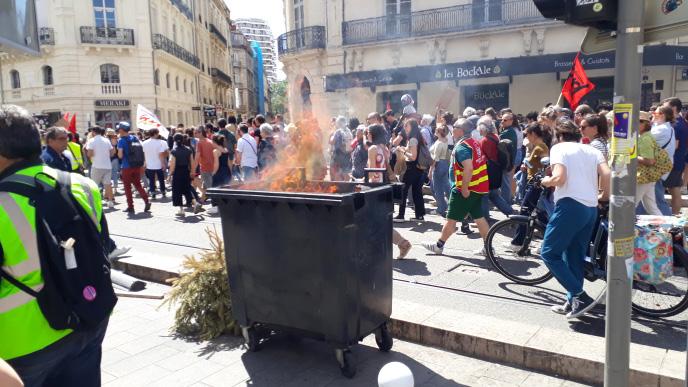
They feel as though their voices are not being heard, and the series of riots and protests over the course of the month is just a preview of their pent-up anger.
They feel as though their voices are not being heard, and the series of riots and protests over the course of the month is just a preview of their pent-up anger. The people are protesting for the heart and soul of France. The majority of the French workforce consists of blue-collar workers, who work long and hard hours in difficult conditions. Public service workers, textile workers, and other blue-collar workers normally have a shorter life expectancy than others, and they tend to start their careers much earlier as well. The two years that these people have lost could have been the difference to them.
From an American perspective, it is quite tricky to interpret the situation. The
median retirement age for people in the U.S. is 67-70.
Most people work for almost the entirety of their lives. I believe that the two-year bump is not such a big deal on both sides of the conflict.
Most people work for almost the entirety of their lives. I believe that the two-year bump is not such a big deal on both sides of the conflict. Two years isn’t enough time to stop bankruptcy, and it also isn’t that much more time to work.
I see this whole situation as a power play.
I see this whole situation as a power play. Emmanuel Macron is showing his true colors by passing this bill, even after his recent re-election.
He does not care about the French people. He is reforming France against her will.
To be remembered
Abdullah Kanchwala ’25
the index · off-campus opinions May 2023 Page 14 French pension protests in Montpellier, France, May 1, 2023 FOURMIDABLE VIA WIKIMEDIA COMOMONS
Owen Yu ’23
Only a handful of people have such significant impacts on their community that they are commemorated for years to come.
If my legacy is solely marked by the everyday interaction I had with others, then I’m glad. If that’s the case, then I know my commitment to those around me had a lasting impact.
Acrash. Debris on the street. Ambulances, police cars. Widespread confusion. Traffic held up for hours.
Let’s face it—four-way intersections stink.
Massive intersections—a staple of the American commute—are a perfect recipe for fatal accidents. Vehicles scream through intersections at whatever speed they desire, and, as a result, deadly head-on collisions are commonplace.
Fortunately, we have a simple solution to this problem: roundabouts.
Already widely popular in Europe, roundabouts—which are eligible for 100% federal funding—lead to a 75% reduction in crashes in which one party is injured. A European study indicated that roundabouts are safer for pedestrians as well, with a 75% reduction in pedestrian collisions.
If all of this seems too good to be true, that’s because it is.
In addition to reducing crashes, roundabouts lead to an 89% reduction in vehicle delays. In other words, rush-hour commutes will be a lot less hectic. By keeping an even traffic flow, roundabouts reduce idling, leading to less air pollution. By eradicating idling, roundabouts reduce carbon dioxide emissions from our vehicles by about 25%.
For some, the time it takes to build a roundabout may be a point of contention. But, with today’s technology, roundabouts can be constructed in just ten days, and while the closure might be a short-term inconvenience, it will pay off in the long run.
Despite these unequivocal benefits,
Revolutionizing roadways: why roundabouts are the future of traffic efficiency

Americans are wary.
Many Americans don’t know how to use a roundabout, which is why we should increase driver education within our nation— but this is another discussion. And, as a The New York Times article discusses, emergency vehicles have difficulty navigating roundabouts. Many people argue that emergency vehicles shouldn’t have to slow down to go through a roundabout.
But do we really need to be worried
about the incremental few seconds it will take an emergency vehicle to slow down, go through the roundabout, and speed back up again?
Also, let’s not pretend that emergency vehicles don’t get held up at four-way intersections. Yes, if the roads were completely empty, it would be easier for an ambulance, firetruck, or police car to navigate a road filled with four-way intersections. However, emergency calls generally occur when most
Stop paying college athletes
A2022 survey resulted in more than fifty percent of Americans in favor of paying college athletes. Why? As an avid college sports’ fan, I feel qualified to say that no college athletes should be paid.
With the recent introduction of Name, Image, and Likeness (NIL) deals, the income
of college athletes skyrocketed from nothing to deals exceeding a million dollars. Young men and women certainly need money for daily necessities such as food or laundry, but they do not need access to hundreds of thousands of dollars. With constantly improving funding and facilities, athletes can and have survived without massive deals. They are

provided the bare necessities: meals, living quarters, clean clothes, and training.
While there are certainly circumstances where paying college athletes would be beneficial, reaching your potential and consistently improving is difficult as an athlete if you make the money before reaching the pros.
Legendary University of Alabama head football coach Nick Saban recently stated, “The issue is, when you create those [collectives] for people, are you establishing a payfor-play type of environment that can be used in recruiting? So now, all the sudden, guys are not going to school where they can create the most value for their future.”
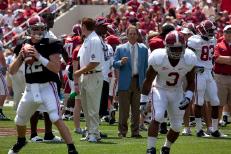
It is unsettling to see seventeen and eighteen-year olds flipping their commitments multiple times throughout their recruitment process. I witnessed it this summer; athletes committing and decommitting multiple times due to broken promises and larger NIL guarantees. Take Jaden Rashada for example. The number-seven ranked quarterback in the class of 2023 committed to three different schools: Miami, Florida, and Arizona State. A teenager flipped his commitment three times in an eight-month span. This is not right.
Still, the individual athletes will not be the only ones affected. The programs, fans, and sports as whole
of the population is awake, when roads are being used. So, does a roundabout really make a trip slower for an emergency vehicle? Probably not.
Implementing roundabouts within our communities is a no-brainer. From safer roads, to less congestion, to aiding the fight to reduce climate change, roundabouts provide many benefits that traditional intersections can not compete with.
will experience downsides due to paying college athletes.
NIL deals could create toxic locker room dynamics, with some athletes making far more than their teammates.
NIL deals could create toxic lockerroom dynamics, with some athletes making far more than their teammates.
These contracts create uneven playing fields within college sports. Programs with wealthy boosters have far more access to high-ranking recruits than smaller, less resourceful schools. This will result in poor play in smaller programs and, in turn, less revenue for a school.
What happens to the Mid-Atlantic or Sun Belt Conference when an SEC school can swoop in and pick off their top recruits by simply offering more money?

The emotional connection to a gameday atmosphere, a coach, or a facility no longer matters in recruitment.
No one wants to lose college athletic traditions, but it is happening before our eyes.
Alex Herrmann ’23
Peter Dunckel ’23
A roundabout with surrounding buildings in a surburban setting
the index · off-campus opinions May 2023 Page 15
NATHAN PALMER, VIA WIKIMEDIA COMMONS
A-Day Game football scrimmage for University of Alabama, with coach Nick Saban analyzing every move
WIKIMEDIA COMMONS
arts
Why young people still watch The Office and Friends

What sort of person would you imagine exchanging a new phone for an older model? If you ask me, I would probably assume it’s someone who is certainly older than I am.
But this logic doesn’t apply to Gen-Z TV habits. Despite the reign of pocket computers, hallway chatter even on our campus has not abandoned shows like The Office or Friends
I have not always been sold on the classics. My response to any suggestion of The Office was the same—a Michael Scott “NOOOOOO!” gif.
With social apps on my phone as a constant companion, and streaming service engines like Netflix and HBO churning new shows faster than can be watched, I saw no need to revert to old television.
But when I stumbled upon Fran Drescher’s The Nanny, a pleaser centering on a saleswoman’s foray into nannying for a wealthy widower and his children, I was immediately hooked on consuming millennialaged entertainment. Soon after, I was invested in Rachel and Ross’s argument over their “break” on Friends. Then I welcomed the humdrum of hating one’s work in The Office
I’m not alone. While many think today’s youth has ditched long-form entertainment for stilted Instagram posts and TikTok videos, we still delve into our fair share of extended television series. According to Horowitz Research, over half of Gen-Z kids consume televised entertainment and interact with TV on a near-daily basis. In terms of access, the difference between having a phone and TV service is even smaller.
So when young people are still watching TV and the megaliths of entertainment are still producing them, how do two shows spanning the late 90s and early 2000s float to the top? Netflix’s users delivered 3% of their total viewing hours to The Office alone in 2019; Friends was close behind.
When Netflix announced the removal
While we may in part exist as reclusive interweb surfers, we are also those tasked with confronting some of our world’s most pressing problems.
of the shows from their streaming service, the sky nearly fell— until other streaming
services picked them up.
What partially contributes to our turn to older TV is a general failure to encapsulate the youth experience. Gen-Z’s constant evolution in a quick-changing world leaves us with dynamism for reinvention. While we may in part exist as reclusive interweb surfers, we are also those tasked with confronting some of our world’s most pressing problems.
The depiction of young people, however, seemingly forgets this multidimensional reality. I recently dove into my family’s new Disney+ subscription. There, I sat unimpressed by the definitive trope of each series. Imagine the cringe of teenage love and cast it to the stars so that its shambles may fall on young people. For every plot, there’s the swoon love interest devoid of a brain, and then a supposedly inept basket case must overcome some superficial imperfection to achieve a happy ending. In this meditation of supposed teenage relationships, cover the voices in a permanent VSCO or jock filter and etch every character in some emotionless competition as phone-bred sycophants.
The only time that some relative emotion can be explored by Gen-Z is through extremes.
Consider Euphoria and its Emmy-winning depiction of a high schooler’s struggles with addiction. Zendaya, who depicts the character Rue’s addiction, is magnificent. But does it take drugs to turn us into authentically emotional people? Without it, are we left to be depicted by shallow TikTokers like Addison Rae? If screenwriters—who I doubt are Gen-Z—can grossly oversimplify the youth experience, then “OK boomer” should be back on the table as a collective young people’s response.
The next generation has more to offer
stay connected.
This is perhaps why Friends is so attractive. Filmed before the infiltration of phones into every facet of our lives, these six friends lived via simple interactions. They were the mundanity and humanity in relationships—those that however challenged were undoubtedly authentic. For the GenZer distanced in the solitude of an Instagram ethos, these innately personal connections seem warm and desirable.
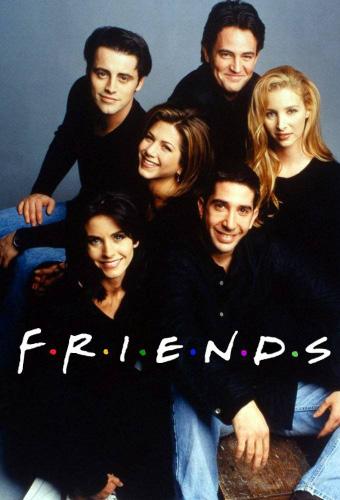
sence pitiful. When Gen-Z’s prospects seem equally uncertain, there’s a comfort to be found in the relatability of the show’s characters.
than a TikToker giving an unconvincing TikTok dance or woeful addiction struggles blended into love triangles that seemingly destroy the universe. When watching Friends or The Office, young people can believe in the context of their generation. Characters are defined by their stories, not by their generation—like how Jim’s aspiration for greater things can complement the humdrum of his office life through his familiar pranks.
But if folks like Addison Rae are truly a product of TikTok, then these are also a product somewhat reflective of Gen-Z. Therefore, our shift to glamorizing old television cannot solely be traced to the nature of modern content itself.
Gen-Z is the loneliest generation in recent memory. Where our predecessors sought driver’s licenses, in-person hangouts, and parties, our immediate access to illusory forms of connection via videogame chats and social media feeds have provided us with a sense of connection. That sense has proven false. Gen-Zers express feelings of stress and depression at rates nearly double their parents. Many young people use new tools to
Beyond relationships, our generation’s future also remains unclear. Whereas many American parents and grandparents once owned their homes, we emerge at a decline in this opportunity. Young people’s buying power is over 80% down from Baby Boomers at the same age. Climate and political conflict also weigh large as an inheritance for Gen-Z’s solution avenues.
For viewers of The Office, the lackluster future and unfortunate prospects of Americans in the workforce is brought to life with comedic effect. With gloomy prospects

If groups of friends or office-goers can better speak to young people than the products of our legacy, perhaps Addison Rae and other TikTok “prodigies” blabbering on young people’s TV shows is an unfortunate reminder of our own dissatisfaction. By extension, that means Gen-Z is not turning back to old TV, but instead staring at the contrast of their dreams clashing with reality in a televised display.
In that split, classics like Friends and The Office offer points of escape better than any show of the present can. What remains to be seen is whether Gen-Z can feed this resonance in recapturing control of its future.
ahead, there’s something comforting about watching others endure a similarly meager livelihood. Those who work in The Office are comically effective because they are in es-
Christopher Schwarting ’24
Poster for The Office
NBC
the index
arts May 2023 Page 16 NBC Poster for Friends
·
The next generation has more to offer than a TikToker giving an unconvincing TikTok dance or woeful addiction struggles blended into love triangles that seemingly destroy the universe.
When Gen-Z’s prospects seem equally uncertain, there’s a comfort to be found in the relatability of the show’s characters.
Alir Gladden ’23 to work on third album for graduation project
Russell Yoh ’24
Sixth Former Alir Gladden has already released two albums, Trash Before Treasure and Dead Hearts. For his graduation project, he is making a third, Just In Case I Die Tonight. So far, Gladden’s albums have consisted of instrumental tracks with hip-hop beats and more mid-tempo lofi tracks. This album, though, is going to be different from his previous work.
“This album is a concept album, so I’m exploring heartbreak and trauma through the scope of therapy sessions. The entire album revolves around a therapy session,” Gladden said. “I have different voices to portray different feelings.”
This will be his first album featuring his own singing and rapping.
words to my music, and I’m proud of my ability to convey my trauma and sadness through the music that I put out.”
Gladden has always been interested in making music, and he is happy to finally be releasing it on streaming platforms.
“As a child, I listened to a lot of music and a lot of hip-hop, and as I got older, I started getting more into who is making the music, who is doing what, and then I wanted to do that. So in sixth grade I started experimenting and I put out music, even though it was terrible. But I kept pushing, and last year I pushed myself to finally release my music on major streaming platforms,” Gladden said.
It was hard for Gladden to be comfortable releasing his music, and he advises others to “keep pushing, even if you think your music is terrible at first. I thought that at first too. It’s good to have a group of people that you know and that you can trust that can give you constructive criticism. It might not always be positive, it might not always be negative, but having those people there to give you the advice that you need is extremely helpful.”
He finds his music to be an important form of self-expression.
This is an exciting new step for Gladden, and he said, “I’m proud of how much I’m pushing myself to express my feelings. This album is the first time I’m putting
“I bring a different voice to Haverford. As a Black man at Haverford, I feel like my voice isn’t often heard, and I feel like my music is a way for me to be able to put myself out there, and see if people can relate. If they can, they can come talk to me and we can have an open conversation,” Gladden said.
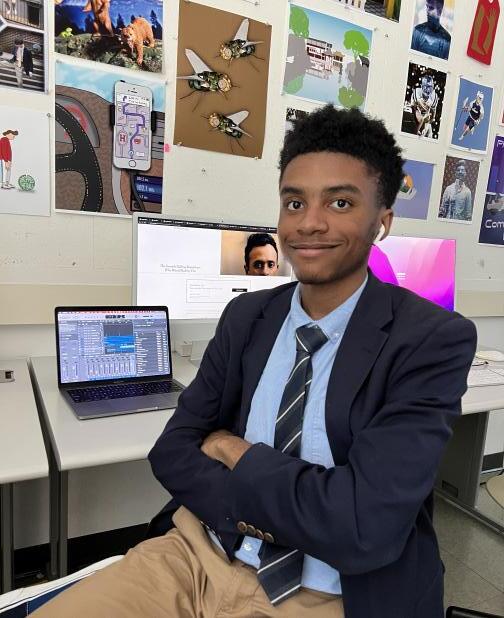
Just In Case I Die Tonight will be released this summer on all streaming platforms.
John Wick 4 proves there’s
on
Keanu Reeves has suited up as the Boogeyman in Black once more, and this time, he’s better than ever.
John Wick: Chapter 4 was released last month to rave reviews, and it’s easy to see why. Grossing $403 million worldwide and holding a 94% Certified Fresh critic score according to Rotten Tomatoes is typically unheard of for an action flick, much less the fourth film in a nine-year-old franchise. At 58 years old, many questioned if Reeves could yet again handle the physicality that a character like John Wick brings. Working with stunt coordinator turned director Chad Stahelski, He puts those doubts to rest in a film filled to the brim with eye-watering spectacle.

Fifth Former Sebastian Golderer believed the hype was well-deserved.
seen the movie. Its greatest moments come in the visceral action sequences, many of which expertly strike an elegant balance between beauty and total carnage.
“There was one overhead shot that went on for like a minute with a fire shotgun,” Golderer said. “It was so awesome to watch, and you have to respect the time and effort that had to go into making that shot alone.”
A common complaint with Chapter 4 is its bloated runtime. At 169 minutes, it is not only the longest John Wick film to date but one of the longest films released this year. Chinese teacher Ms. Yi Lee saw the movie at its release and agreed that it was too long.
“It is kind of long for a movie without too much dialogue,” she said.
Still, at almost three hours, moviegoers have continued to praise the flick. But unfortunately, there are no plans for an immediate sequel in the near future.
“I’m always saying, ‘This is my last one, this will never happen again,’” Stahelski said in an interview before the film’s release. “And I’ll say that now: This is my last one.”
“I think it was a good way to end the series,” he explains. “John Wick is really cool because it’s super creative with how it uses its action… I don’t really like guns that much in action movies because they’re kind of boring, but they still managed to make them really interesting.”
His feelings are echoed by many who’ve
Even if there is no John Wick 5, the franchise will continue to stand above the rest in the action genre, and the fourth film is an exceptionally high note that will be tough to match.
Alir Gladden ’23
still life in the franchise, nearly 10 years
Alir Gladden ’23
the index · arts May 2023 Page 17 TRIPP RONON ’24 LIONSGATE
Poster for John Wick: Chapter 4
“This album is the first time I’m putting words to my music, and I’m proud of my ability to convey my trauma and sadness through the music that I put out.”
ALIR GLADDEN ’23
“I think it was a good way to end the series. John Wick is really cool because it’s super creative with how it uses its action.”
SEBASTIAN GOLDERER ’24
Even if there is no John Wick 5, the franchise will continue to stand above the rest in the action genre.
Taylor Swift’s Eras tour: A journey through her career
STaylor Swift’s highly anticipated “The Eras Tour” is coming to Philadelphia from May 12-14. It is a journey through the artist’s ten albums, each serving their own era.

Essentially, this tour is a celebration of Taylor Swift.
If you have been living under a rock your entire life and cannot name all ten of her critically acclaimed albums, I’ll do it for you. Starting off we have the self-titled album Taylor Swift—known as “Debut” by her fans—released in 2006. This is a country album composed and written by a 17-yearold Taylor trying to find “A Place in This World” after moving to Nashville, Tennessee.
Her sophomore album, Fearless, was released in 2008. This country album spawned the hits “You Belong With Me” and “Love Story.” Funnily enough, at the end of concerts, when “Love Story” is performed on stage, fans have been proposing to their own lovers during the final chorus where Swift sings: “He knelt to the ground and pulled out a ring.”
After the success of Fearless, Swift released Speak Now in 2010. Each song on Speak Now is a letter containing all that she never got to say to a lover, friend, or after the 2009 VMAs incident, the disgraced Kanye West. This music on the album focuses on retrospection and is now lesser known by the general public—even though she went on a world tour—and is overshadowed by her following album, Red.
You might know this album from Swift’s first Billboard No. 1 hit “We Are Never Getting Back Together.” Furthermore, when the “Taylor’s Version” of this album was released in 2022, it featured a ten-minute “All Too Well,” the longest song to reach the No. 1 spot on Billboard’s Hot 100.
GRAMMY Awards (2016). This pop album is home to three iconic music videos, “Bad Blood,” which won a Grammy for best music video, “Shake It Off,” and “Blank Space,” with a combined total of 7.8 billion views on YouTube.
For the next year following 1989’s success, Swift disappeared from the media. With her Instagram bare, her fans were left to scour Tumblr for any sign of life. “Look What You Made Me Do,” the first single released from her sixth album Reputation, arose from a wild controversy between Taylor and the Kardashians. In full, the Reputation era was about confronting the rumors about her and sorting through the fakes and the snakes.
Swift announced the tour on November 1, 2022, and over 3.5 million fans signed up to receive Verified Fan Presale codes through Ticketmaster. On the first day of ticket sales, Nov 15, Taylor Swift sold 2.4 million tickets. She now holds the record for most tickets sold in a single day. In an unfortunate turn of events, this day and this ticket-marketing process would go down in infamy within the Swiftie fandom and across the country. Swifties nationwide logged onto Ticketmaster only to wait in queues besieged with bots. Then Ticketmaster crashed, sending them all the way back to square one. Illusory service fees plagued users, and Ticketmaster’s incredibly poor handling of the ticket sales have become a preface to the class action lawsuit filed against Ticketmaster and their parent company LiveNation. The monopoly that LiveNation exhibits, violation of antitrust laws, and its rigged arbitration process are the merits of which it is being sued. The plaintiffs are seeking financial compensation and a governmental revision on the status of Ticketmaster’s monopoly.
are dressing up as their favorite Taylor Swift era. For fans who grew up with Curly Blond Hair (from where she gets the fandom nickname: “Blondie”) and cowboy boots, expect to find them dressed as preppy cowgirls. Other common eras outfits are those that resemble a disco ball, based on her song “mirrorball,” and the iconic “Not A Lot Going On At The Moment” shirt from her music video for the song “22.” Furthermore, fans donning cardigans, cottagecore dresses, and bringing their “key lime green dogs” along with them are living the best folklore lives. Bright pastels and pinks signify a Lover theme, while dark robes, silver spikes, and eyeliner allude to the Reputation era. Finally, a midnight blue dress, a bejeweled outfit of sorts, is a dead giveaway to Midnights
1989: Swift’s birth year holds the title of Album of the Year from the 58th Annual
Overcoming the turmoil, Taylor Swift entered her Lover era and made things official with her boyfriend at the time, Joe Alwyn. In 2020, Loverfest was planned but, surprise, surprise… COVID. Hence, the absurd prices and hype built for The Eras Tour are because it will be the first time Swift has toured since 2018 for reputation.
Although COVID was an unfortunate time, Swift delivered the magnum opus of her career during this time. At the 2020 GRAMMY Awards, folklore won Album of the Year. Next, folklore’s sister album, Evermore, was released four months later. Within the fandom, Evermore is seen as a compilation of songs that weren’t good enough to make the original album. Finally, at the 2022 MTV VMAs Taylor announced the arrival of Midnights. As her most recent album of the ten, Midnights exists as a love letter to herself and her career.
The Eras tour kicked off in Glendale, Arizona on May 5. The American leg is set to end on August 5 in Los Angeles. On her tour, Taylor brings along nine special guests: Paramore, beabadoobee, Phoebe Bridgers, girl in red, MUNA, HAIM, GAYLE, Gracie Abrams, and OWENN. It’s cool to see an artist with such a large platform elevating smaller artists who make amazing music. For an artist like GAYLE, who blew up on TikTok with her single “abcdefu,” going to see Swift on tour in 2018 and then touring with her five years later is quite phenomenal. Presumably, Swift chose GAYLE as she would be able to engage with a younger audience.
Another fun Swiftie Eras Tour festivity is making and trading Taylor Swift-themed friendship bracelets. This was inspired by the line “So make the Friendship Bracelets/Take the moment and taste it” from the bridge of the Midnights track “You’re On Your Own Kid.” Made out of beads or string, on these bracelets you might find references to certain songs, eras, events, or niche jokes from within the community.
The last bit of Swiftie knowledge one must know before the big night is certain traditions within a few particular songs. The oldest tradition, starting on the Fearless Tour, is the double clap after the line “I’m the one who makes you laugh when you know you’re ‘bout to cry” in “You Belong With Me.” Next, her song “Bad Blood” with Kendrick Lamar obviously cannot be performed with Kendrick on stage, but one line that Swifties always say from his rap comes once again, during the bridge. When Taylor sings “Band-aids don’t fix bullet holes/You say sorry just for show,” fans will sing “You forgive you forget but you never let it (beat) go.”
In 20 years time, it will be clear that if you didn’t go to The Eras Tour, you didn’t truly live. This tour will introduce new Swifties of all ages and give old-gen Swifties a retrospective experience on Taylor’s impact on the music industry.
You’ll find me screaming at the top of my lungs at her show on May 13th.
Per the title The Eras Tour, many fans
For the next year following 1989’s success, Taylor disappeared from the media.
In 20 years time, it will be clear that if you didn’t go to The Eras Tour, you didn’t truly live.
Liam French ’25
RONALD WOAN VIA FLIKR the index · arts May 2023 Page 18
Taylor Swift’s Eras Tour in Arlington, Texas, March 31, 2023
Hence, the absurd prices and hype built for The Eras Tour are because it will be the first time Swift has toured since 2018 for reputation.
sports
Fords Lacrosse stays grounded amid championship buzz
 Adiyan Nayak ’24
Adiyan Nayak ’24
With the end of the spring sports season comes one of the most notable athletic events of the year: the Inter-Ac lacrosse tournament. Expectations are now higher than ever after an especially successful season. This past weekend, the team reached a new high with a dramatic 16-15 victory over St. Anthony’s High School, the highest-ranked high school team in the country.
Within the Inter-Ac, they are undefeated, the most significant result being their 11-10 overtime win against Malvern Prep, completing the sweep of their rival and helping to win the Inter-Ac regular season.
“[Sweeping Malvern] was definitely great for the team and the program, the first time we’ve swept them in quite a while. It was just great to see all the hard work come together,” Sixth Former Wells Flinn said.
When Sixth Former Wills Burt scored the game-winning goal in overtime, it became apparent that this year’s group had something special. Flinn, who scored a decisive goal to secure the win against St. Anthony’s, has been a key part of the Sixth Form group leading the roster.
“As seniors, I feel like we’ve set the example, and have taken what past seniors and past leaders have done, and just employed that in the team now,” Flinn said. “Everyone top to bottom works hard and plays well together.”
Head Coach Brendan Dawson has been especially pleased with the leadership thus far.
“They’ve had their eye on the prize the entire season,” Coach Dawson said. “They’ve been really focused and since the beginning of the year they’ve been working to that point they’ve been all trying to get to, that end-of-year hurdle, which has been a hurdle for us for a couple of years here.”
Sixth Former Ryan DiRocco has stressed the importance of focusing on improving every day, a message that he feels the team has already believed.
“Just taking every practice one day at a time, every game one game at a time, that’s the mindset,” DiRocco said. “I think our team is already thinking that way, so there’s not much I need to do to convince them to stay focused on the day.”
That daily focus will be especially important in the coming weeks, as the team gears up for the Inter-Ac tournament, a topic that is already filling the halls of the upper school.
“That’s all outside noise that you’ve got to block out. Because if you listen to it, it starts to become dangerous,” Coach Dawson said. “The seniors have been great about that focus, so I expect that they’ll continue to help us with that here down the stretch.”
Students in Wilson Hall have already started making plans for the Inter-Ac cham-
Crew, cont. from first page
“Our training is usually a mix: on-land training and on-water,” Sixth Former Evan Wang said. “We’ve all put so much work on and off the river.”
The team now looks forward to end-ofseason championship regattas, especially the
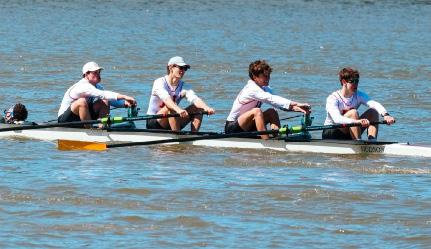
Stotesbury Regatta: the world’s largest high school regatta, where the team hopes to earn gold for the third year in a row.
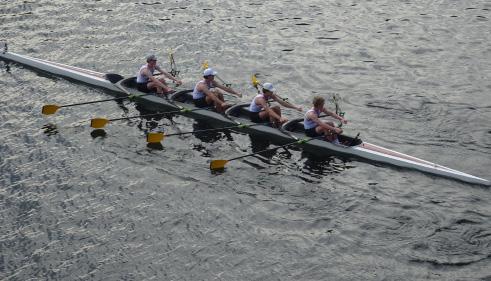
“We finished our regular season strong with a few big wins, and now we are looking forward to bringing the same energy to
pionship, many assuming a rematch with Malvern is inevitable.
“One of the things we’ve been talking about is that you’ve got to earn the right to do that. May lacrosse is not guaranteed. It’s something that you’ve got to put yourself in a position to win,” Coach Dawson said. “The only thing we can do is focus on what’s here, and if we have an opportunity to play a team again— whether it’s the second, third, fourth, or eighth time—it’s just about trying to go out and be our best on that day. If we can focus on that, I think that helps with the buzz, and the people talking about games and all that sort of stuff.”
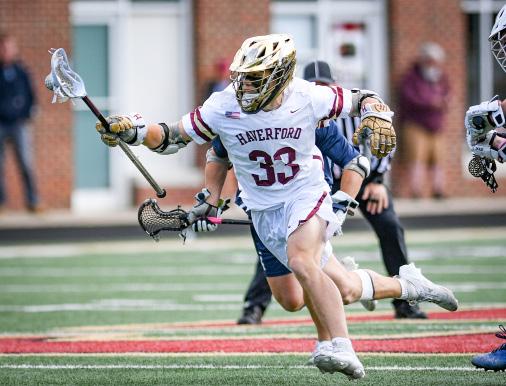
Coach Dawson’s message has clearly been received.
“We’re not there yet,” Flinn said of the Inter-Ac tournament. “We’ve just got to focus on what’s on hand, and not get too ahead of ourselves.”
Along with avoiding distractions, the players—especially the sixth formers—must also deal with the pressure of expectations and the finality of the season. Coach Dawson’s emphasis on staying in the moment will also be helpful in dealing with this pressure.
“I’m a big believer that if you focus on what’s right in front of you, the anxiety about what’s to come is really not that big of a deal; it’s really just another day when you get there,” Coach Dawson said.
Coach Dawson is hoping that the players will also be able to appreciate their opportunity and embrace the joy of their upcoming challenges.
“The other thing we’ve really been talking about this year is just being grateful for the opportunity,” Coach Dawson said. “It doesn’t totally relieve the butterflies and the nervousness, but it can take a little bit of that anxiety away. It’s just another opportunity to go out and compete and have fun with your friends, and play the game that you love.”
That gratitude will never be more valuable than it is now, with the seniors suiting up for their final few games in the Haverford uniform.
“It’s just been awesome playing for the last four years with my friends,” DiRocco said. “We’re grateful for all the success we’ve had so far this season, and we’re just excited. I think we’re more excited than we’re feeling pressure.”
City Champs and Stotesbury,” Fifth Former Joseph Herd said.
For year-round rowers, Stotesbury Regatta and City Champs are more than just the “playoffs.” They are what the rowers have been preparing for throughout the whole
year.
“[Stotesbury Regatta and City Champs] are sort of in the back of your head every practice,” Fifth Former William Walker said. “Especially in the winter, the motivation to work hard is all fueled by these races.”
the index · sports May 2023 Page 19
COMMUNICATIONS
Ben McCarthy ’24 picks up a ground ball in an 18-9 blowout of Episcopal Academy, April 25, 2023
Laxmen talk things over
MS. LAURA BARR
Rowers Jackson Harrington ’24, Noah Kanefsky ’25, Joseph Herd ’24, and Ben Erskine ’25 row in an April Flick
COURTESY OF QUINTIN BOWERS
HARRISON MCCULLOUGH ‘23
‘24
Ryan Gibson ’24, Jack Suter ’23, Michael Bartholdson ’25, and Quintin Bowers ’24 row in a recent Flick
The Ultimate scandal
“The Haverford Ultimate Team is a group of guys just wanting to have a good time,” Sixth Former and captain Matt Franz said. “We don’t go into games expecting to win—just to have some fun.” Ultimate Frisbee is, at its core, a lighthearted game, and most of the team seems to enjoy their time on the field.
This game was different.
On Wednesday, April 29, Fords Frizz was set to play against Springfield Ultimate Association. Although it appeared as if it were about to storm, the weather held out. As the teams walked onto the field, it was obvious which team was more organized. While Springfield looked more put together, the Fords showed more athleticism.
Fifth Former Connor Gillespie, the team handler (disk thrower), said before the
game, “I’m feeling good about this one, we might be able to scrape out a win.”
In the first possession, Springfield scored. It didn’t even take a minute.
In the second possession, the Fords made an incredible march downfield, making quick passes, swinging it across the field, and then bombing it deep into the backline.
Fifth Former Brady Miles, the other handler of the team, made a laser from 60 yards into the endzone. But as the frisbee came down, Springfield called a foul: pick.
A foul is rarely called in frisbee, let alone this call. It means that the offense physically blocked the defense from running to the disc. Many of the Fords found this call weak.
“That was [BS]. I had him beat by a mile,” Sixth Former Cole Pressman said, This foul soon became the downfall of
the Fords.
Frisbee has no refs. It is governed by the players and “the spirit of the game.” When a foul is called, the play is automatically reset, and the penalty is decided amongst the players. As long as both teams are good sports, it runs smoothly, but it also gives players the ability to abuse this power.
there was a pick, every short pass was a double team, and every score wasn’t quite in. Springfield played a tight, regimented game.
By halftime, the score was 3-8, Springfield up. As it started to drizzle, the Fords shared their frustration.
“We can’t make a play without them calling a foul,” Miles said. “It’s impossible to do anything.”
Other Fords shared this opinion, noting that Springfield was beatable.
Dark clouds began to set in as the game progressed. Haverford was not able to score a single point for the rest of the match.
And Springfield kept calling weak fouls.
It seemed like there was a foul in every possession. Not a single foul was called by Haverford on Springfield. Every deep bomb
“The worst part is that they are winning by ten points. They don’t need to be doing this,” Sixth Former Ebaad Khan said. “Playing against this team is just infuriating.”
“While some of these calls are valid, a lot of them are… iffy,” Coach Andrew Fenton said,
By the end of the game, the final score was 3-15. It began to pour as the teams lined up to shake hands.
The Fords stayed silent.
“That didn’t feel deserved,” Sixth Former Willys Silvers said. “That was the first frisbee game I played [where] I didn’t have fun.”
For the first time in Fords’ Frisbee history, every single player left the game looking upset. Haverford Frisbee is no stranger to losing by ten or more points, but this game was different.
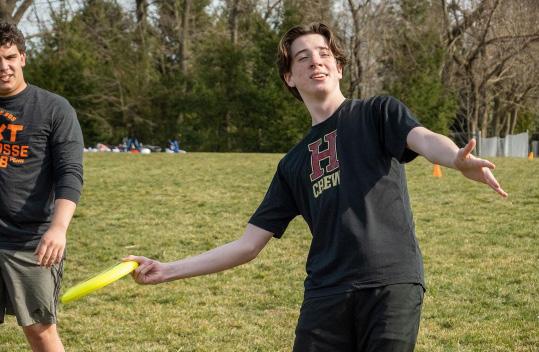
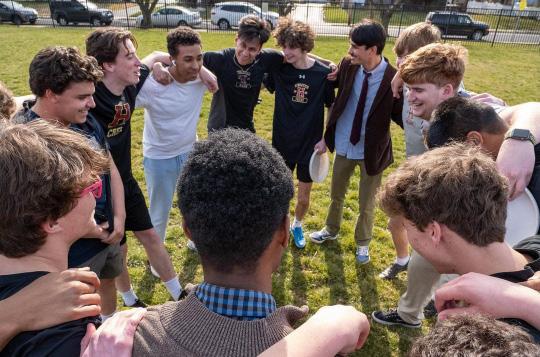 The Fords walked off the team not only losing the game, but losing their spirits.
The Fords walked off the team not only losing the game, but losing their spirits.
COURTESY OF THE FORDS ULTIMATE INSTAGRAM PAGE
Zach Elder ’23
“That was [BS]. I had him beat by a mile.”
the index · sports May 2023 Page 20
COLE PRESSMAN ’23
COURTESY OF THE FORDS ULTIMATE INSTAGRAM PAGE
Fords Ultimate huddles during a recent practice
For the first time in Fords’ frisbee history, every single player left the game looking upset.
Zach Elder ‘23 winds up a toss



































 Ryan Hu ’26
Ryan Hu ’26

















 Adiyan Nayak ’24
Adiyan Nayak ’24




 The Fords walked off the team not only losing the game, but losing their spirits.
The Fords walked off the team not only losing the game, but losing their spirits.